5 Reasons Why Your Cruise Control Stopped Working
- Updated: March 15, 2023
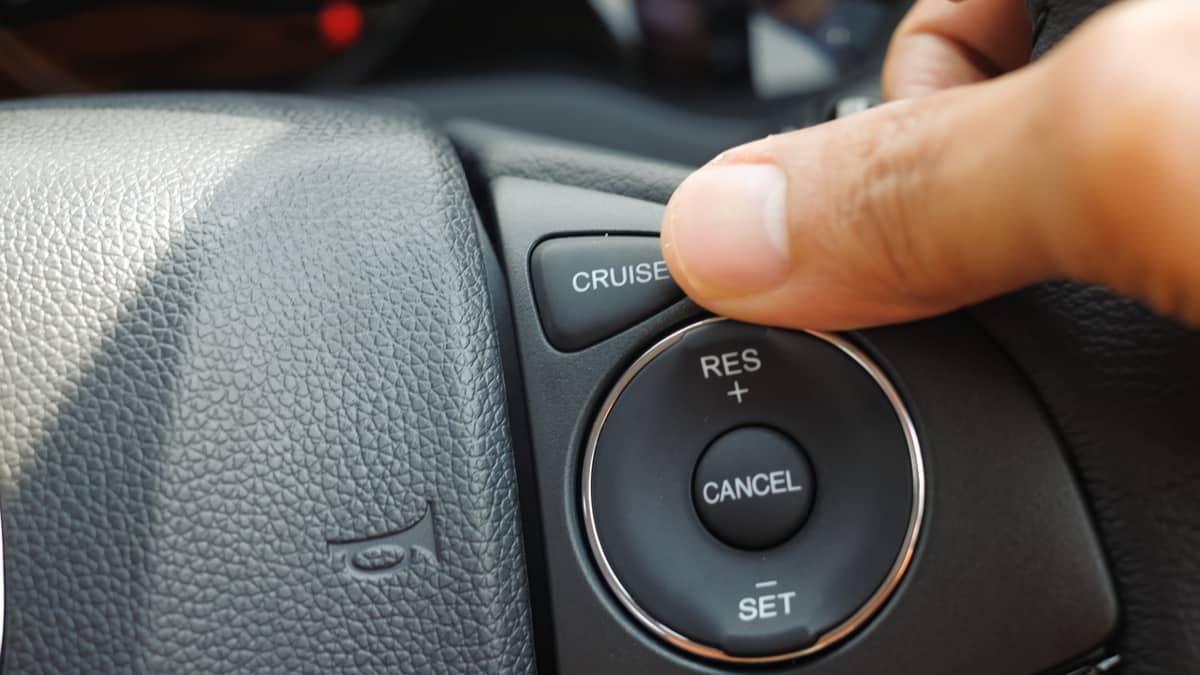
It would be difficult to find a vehicle on the road today without cruise control. This invaluable feature makes driving long distances easier but can also cause trouble when it malfunctions. Understanding the reasons your cruise control stopped working ensures that you can get the problem fixed quickly for a more enjoyable ride.
While this fault can cause issues with the cruise control system itself, there could also be an effect on the acceleration of your vehicle. That’s why you want to have it looked at as soon as you notice a problem. Let’s take a quick look at the reasons your cruise control may have stopped working.

Reasons Why Your Cruise Control Stopped Working
The most common reason a cruise control stops working is due to a blown fuse or a defective brake pedal switch . It can also be caused by issues with the throttle control system or the ABS. In older cruise control systems, it can be caused by a broken vacuum line.
Here is a more detailed list of the possible reasons your cruise control is not working:
1. Blown Fuse
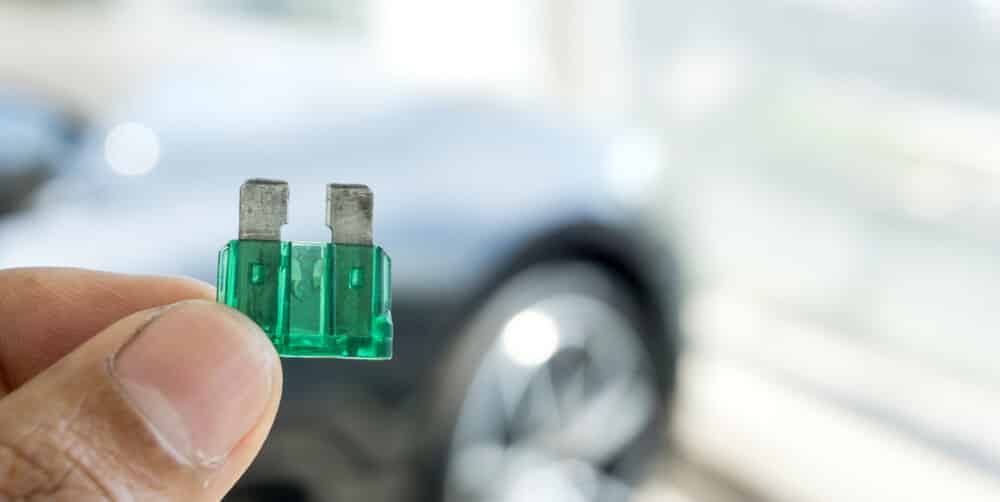
All electrical systems in the vehicle are controlled by fuses. Your cruise control system is attached to a fuse that can blow if there is a short circuit or fault. Without a good fuse, the cruise control system can’t work at all.
Thankfully, it’s not difficult to find and replace a blown fuse. Look in the owner’s manual to find the fuse that corresponds with the cruise control technology.
2. Defective Brake Pedal Switch
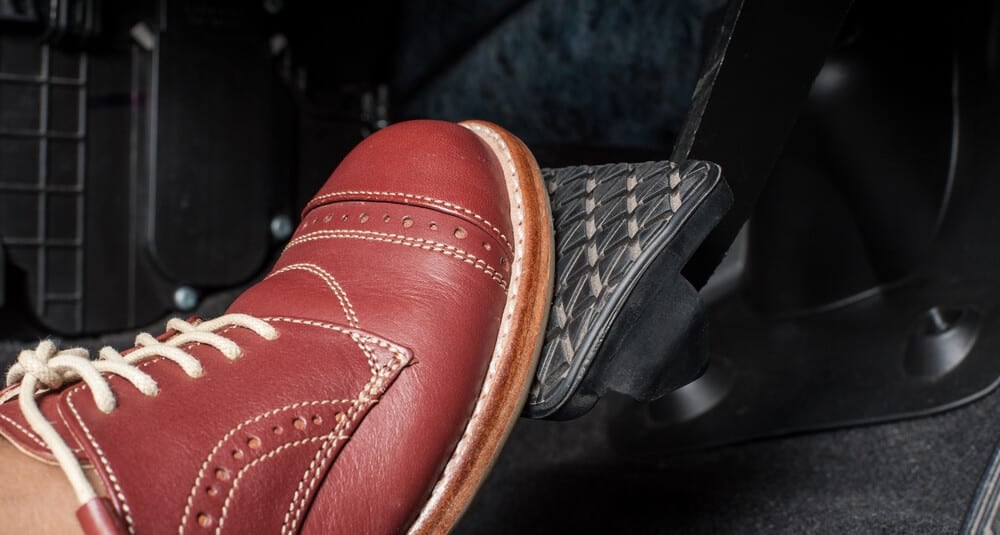
The brake pedal switch is responsible for turning the brake lights on and off based on the pedal position. Cruise control systems are designed to disengage whenever your brake pedal gets pressed.
Because the cruise control is wired into the brake pedal switch, any fault can cause it to stop working. When the brake pedal switch malfunctions, the car believes the brakes are engaged, causing the system to turn off automatically. Not only that, but your car’s brake light might also be stuck on, leaving confused drivers in your wake.
3. Malfunctioning Speed Sensor
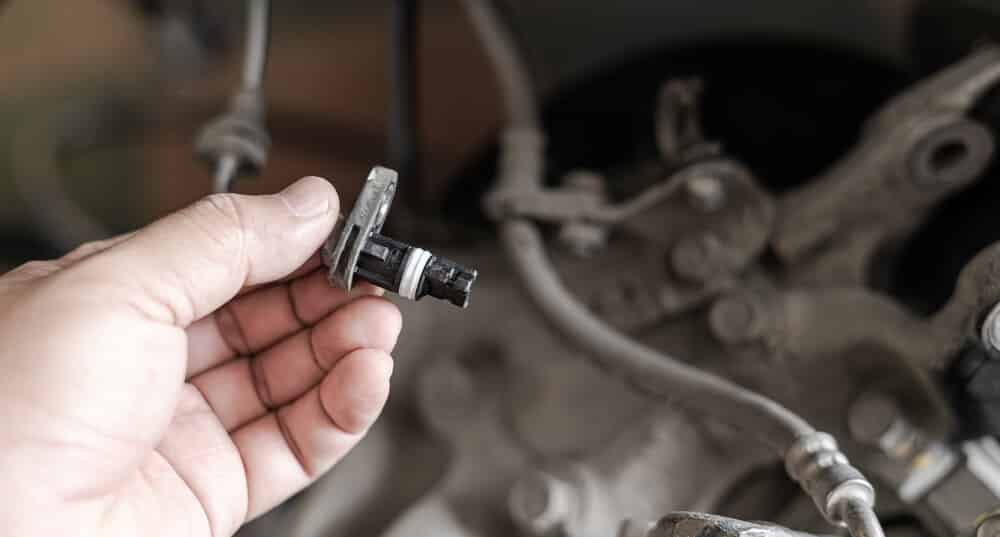
Speed sensors are located on every wheel or differential. The purpose of these sensors is to monitor the speed of the wheels to determine if traction control is needed.
The speed sensors are also part of the cruise control system. When a sensor fails, the cruise control can stop working and the speedometer might act strange as well.
If there is an issue with a speed sensor, it will often show with an ABS warning light or a check engine light on the dashboard.
RELATED: 3 Symptoms of a Bad ABS Wheel Speed Sensor
4. Electrical Issues
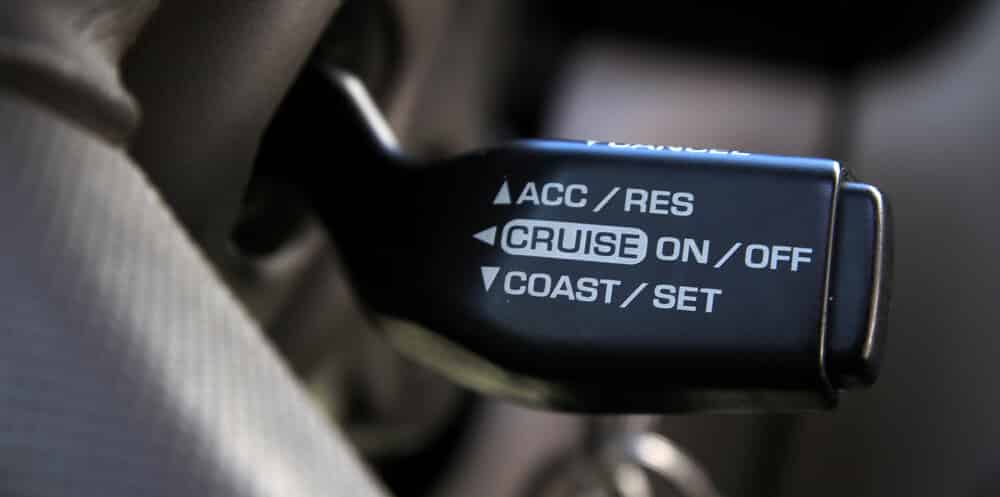
The cruise control system is electronic, with many components working together to make the system operate. If the cruise control fails to work, you want to check the wiring harness and associated connectors for a fault.
You also need to ensure that the voltage source is supplying enough power to the system. Even the smallest fault can cause defects with the cruise control. In many cases, there can be an issue with the cruise control lever or buttons causing the cruise control to not engage.
If your cruise control buttons are located on the steering wheel it could also be caused by a bad clock spring, which is located behind the steering wheel.
Check the system with an OBD2 scanner to look for any trouble codes related to the cruise control.
RELATED: 5 Symptoms of a Broken Clock Spring, Location & Replacement Cost
5. Damaged Vacuum Actuator, Hoses or Cable (Older cruise control)
If you drive an older vehicle with cruise control, you might have an issue with the vacuum actuator or the cable that connects to the throttle. If there has been damage done to the vacuum hoses or the actuator, the cruise control will stop working altogether.
Additionally, the cable linking the actuator to the throttle must be in good shape. If it has been broken, the cruise control will fail.
What is Cruise Control?
Cruise control is a feature that is used when you are traveling at a consistent speed. Cruise control was first introduced for automobiles in the 1950s. However, it took many years before it became a staple in the modern vehicle.
This electrical system allows you to set a predetermined speed and take your foot off of the gas pedal. If you are on a long drive, there is less fatigue because you don’t have to try to maintain your speed. Cruise control can also benefit fuel economy because the vehicle uses less fuel when traveling steadily.
In newer cars, you might be able to find adaptive cruise control , which is a smart technology. Adaptive cruise control allows you to travel at a predetermined speed, but it also helps to maintain a safe distance from the vehicles in front of you with the help of sensors. With conventional cruise control, you need to take over when the car in front of you slows down, but that’s not the case with adaptive cruise control.
There are also vehicles nowadays with not only cruise control, but fully self-driving vehicles . We will most likely see much more of this in the future.
Cruise Control Repair Cost
The cost to repair your cruise control system depends on what caused it to fail. If you need to replace a cruise control or brake switch, you might spend between $125 and $350, including parts and labor. However, the cost to change a fuse is only a few dollars and you can perform the replacement yourself in just a matter of seconds.
On the other hand, when something major fails, such as the actuator, you could be looking at a much higher repair bill. In some vehicles, the cost to replace a cruise control actuator can cost more than $700. These costs rise if you drive a luxury vehicle or one that is difficult to get parts for.
It might not seem immediately important for you to fix the broken cruise control, but this defective system can affect other performance aspects. You could start to notice issues with acceleration or have trouble with the speedometer. To play it safe, it’s always best to have the cruise control repaired as soon as you notice a problem.
Is there a fuse for the cruise control?
Yes. If the cruise control is installed from the factory, you should check your car’s owner’s manual for the fuse location. If it’s an aftermarket cruise control, you’ll need to follow the wires to find the fuse.
Does the brake switch affect the cruise control system?
Yes. The brake switch affects the cruise control system. The brake switch sends a signal to the cruise control system to let it know when the brakes are being applied for the engine to know when it should stop accelerating.
Will the cruise control work if the check engine light is on?
The cruise control function will be disabled when the check engine light is on in most car models, even if the cause of the check engine light is not the cruise control itself. This is mainly due to safety reasons.
Can a vacuum leak affect cruise control?
Older vehicles use vacuum to control the throttle for the cruise control, and in this case a vacuum leak can heavily affect the cruise control. However, modern cruise controls are fully electric and in most cases will not be affected by a vacuum leak if the check engine light is not illuminated.
Although many people may think that the cruise control system is unimportant and not worth spending money to repair, the problem can be caused by a faulty part that will affect the engine’s performance or durability. Therefore, it is best not to ignore the problem if your cruise control is not working without first diagnosing the car properly.
If your cruise control still isn’t working after trying all the tips in this article, it’s probably time to take it in for a professional opinion from a mechanic. It may be a more serious problem that requires replacement parts or repairs. In the meantime, drive safe and enjoy the open road!
Learn more:
- Brake Lights Not Working But Tail Lights Are? (How to Fix)
- Tail Lights Not Working But Brake Lights Are? (How to Fix)
- Brake Lights Stay On? (5 Causes & How to Fix it)
Categories: Electric , Troubleshooting
Related Posts

Latest Posts
- The Best & Worst Years Of Ford Explorer
- Best & Worst Years Of Toyota Corolla
- Best & Worst Years of Toyota RAV4
- When Should Your Child Switch To A Forward-Facing Car Seat?
- The Best & Worst Years Of Toyota Camry
- I Accidentally Put Premium Gas In My Car, What To Do?
- PRO Courses Guides New Tech Help Pro Expert Videos About wikiHow Pro Upgrade Sign In
- EDIT Edit this Article
- EXPLORE Tech Help Pro About Us Random Article Quizzes Request a New Article Community Dashboard This Or That Game Happiness Hub Popular Categories Arts and Entertainment Artwork Books Movies Computers and Electronics Computers Phone Skills Technology Hacks Health Men's Health Mental Health Women's Health Relationships Dating Love Relationship Issues Hobbies and Crafts Crafts Drawing Games Education & Communication Communication Skills Personal Development Studying Personal Care and Style Fashion Hair Care Personal Hygiene Youth Personal Care School Stuff Dating All Categories Arts and Entertainment Finance and Business Home and Garden Relationship Quizzes Cars & Other Vehicles Food and Entertaining Personal Care and Style Sports and Fitness Computers and Electronics Health Pets and Animals Travel Education & Communication Hobbies and Crafts Philosophy and Religion Work World Family Life Holidays and Traditions Relationships Youth
- Browse Articles
- Learn Something New
- Quizzes Hot
- Happiness Hub
- This Or That Game
- Train Your Brain
- Explore More
- Support wikiHow
- About wikiHow
- Log in / Sign up
- Cars & Other Vehicles
- Car Maintenance and Repair
Why Your Cruise Control Isn't Working
Last Updated: June 10, 2024 Fact Checked
Cruise Control Failure: Causes & Solutions
What happens if cruise control stops working.
This article was reviewed by Jason Shackelford and by wikiHow staff writer, Eric McClure . Jason Shackelford is the Owner of Stingray Auto Repair, a family owned and operated auto repair shop with locations in Seattle and Redmond, Washington. He has over 24 years of experience in auto repair and services, and every single technician on Jason’s team has more than 10 years of experience. This article has been fact-checked, ensuring the accuracy of any cited facts and confirming the authority of its sources. This article has been viewed 1,359 times.
Cruise control allows you to take your foot off of the gas pedal while maintaining a set speed so that your foot can get a break when you’re on long stretches of road with no traffic. However, there are a few common (and usually minor) automotive issues that can keep cruise control from functioning correctly. In this article, we’ll break down what might be going on so that you can fix the issue and get back to cruising comfortably.
Why Would Cruise Control Stop Working?
In most cases, cruise control stops working because of a blown fuse, faulty brake light, or bad brake switch. However, a check engine light or an engine-related issue could prevent your cruise control from working.

- Diagnosing this problem: Refer to your manual to locate the fuse box in your engine bay. With a cold car, pop the fuse box and remove the fuse dedicated to the cruise control. Either test the fuse with a multimeter or hold it up to a light source and inspect the wire inside to see if it is broken.
- Fixing the issue: Either see a mechanic or purchase a replacement fuse for your make and model. Insert the new fuse into the slot for the cruise control system and you’re good to go.
- Potential cost of repair: A new fuse shouldn’t run more than $10-30 unless you drive an exotic car. A mechanic will probably charge $100-200.

- Diagnosing this problem: Have a friend sit in your driver’s seat and press the brake pedal. Walk around your car and confirm the brake lights are working.
- Fixing the issue: If any of the brake lights are out, replace the bulbs . Your cruise control should come back on.
- Potential cost of repair: Seeing a mechanic for this will run $100 or so, plus the cost of the bulb. If you replace the light yourself, it shouldn’t cost more than $5-20 for the bulb.

- Diagnosing this problem: Have a friend sit behind the wheel and press the brake pedal to see what happens. If none of the lights come on—even after changing the bulbs—your brake switch is likely bad.
- Fixing the issue: A brake switch repair requires a professional mechanic, so take your vehicle to an automotive pro.
- Potential cost of repair: Luckily, brake switches are cheap and the repair is easy for a professional. Expect to pay roughly $75-100 depending on the shop minimum.

- Diagnosing this problem: Check your speedometer while you drive. If it isn’t working properly, the speed sensor is bad.
- Fixing the issue: See a mechanic to have the speed sensor replaced.
- Potential cost of repair: It depends on whether your speed sensor is embedded in the transmission or not. If it is, the repair may run up to $1,000. If it’s tucked behind your dashboard, it should only cost $100 or so.

- Diagnosing this problem: If your check engine light is on, it’s likely what’s keeping your cruise control off. Diagnose the issue by plugging in an OBD2 scan tool in your vehicle’s OBD port and running a scan to determine what the issue is.
- Fixing the issue: See a mechanic to have the underlying problem addressed (and the issue diagnosed, if needed).
- Potential cost of repair: The cost depends on the underlying problem. Something as simple as a new gas cap may only cost the shop minimum, but new spark plugs, engine damage, crankshaft failure, and other issues will cost much more.

- Diagnosing this problem: This is a tough issue to diagnose, but it will usually pop up in the error codes if you run an OBD2 scan .
- Fixing the issue: See a professional auto mechanic to have the vacuum actuator replaced.
- Potential cost of repair: The cost of the repair depends on the design of your actuator and whether it can be salvaged or not. It may cost anywhere from $200 to $2,000.

- Diagnosing this problem: Run an OBD2 scan to see if the ECU or ICM are throwing error codes.
- Fixing the issue: This is one of the more complicated issues you can run into, so see a mechanic to have them rewire a new ECU or ICM.
- Potential cost of repair: You’re probably looking at a $300-800 repair, but it can vary depending on the make and model of your car.

- Diagnosing this problem: You should be able to tell if this is the problem just by testing the pressure of the button.
- Fixing the issue: You can normally pop off the cruise control button with a flathead screwdriver and then clean it or replace it.
- Potential cost of repair: A new cruise control button shouldn’t run more than a few dollars.

Expert Q&A
You might also like.

- ↑ https://www.hancockclarion.com/2020/08/26/cobalts-are-just-weird/
- ↑ https://mycardoeswhat.org/deeper-learning/adaptive-cruise-control/
- ↑ https://www.customcompleteautomotive.com/blog/5-reasons-why-your-cruise-control-is-not-working
- ↑ https://klifex.ua/en/zaglushki-vihrevyh-zaslonok-i-komplekty-egr-egr/vakuumnyye-aktuatory
- ↑ https://youtu.be/49SjHjnnVn4?t=38
About This Article

- Send fan mail to authors
Did this article help you?

Featured Articles

Trending Articles

Watch Articles

- Terms of Use
- Privacy Policy
- Do Not Sell or Share My Info
- Not Selling Info
Get all the best how-tos!
Sign up for wikiHow's weekly email newsletter

Cruise Control not Working (Diagnosis and Troubleshooting)
What makes cruise control not work.
Bad brake pedal/light switch — This means communication between you, cruise control and the car is interrupted, and you can’t have immediate manual control of the car.
Bad fuse — Fuses blow to protect the electrical system. Cruise control fuses will do the same, to protect the system and circuits in your car the fuse will break and then need repairing.
Failing speed sensor — Speed sensors are important in cruise control because your car needs to remain at the same speed consistently. Broken speed sensors will affect more than cruise control and need to be serviced urgently
Bad actuator vacuum, hose, or cable –The actuator vacuum is what connects and activates the throttle control. The fault may be with the hoses in the vacuum actuator or the cable linking the system together.
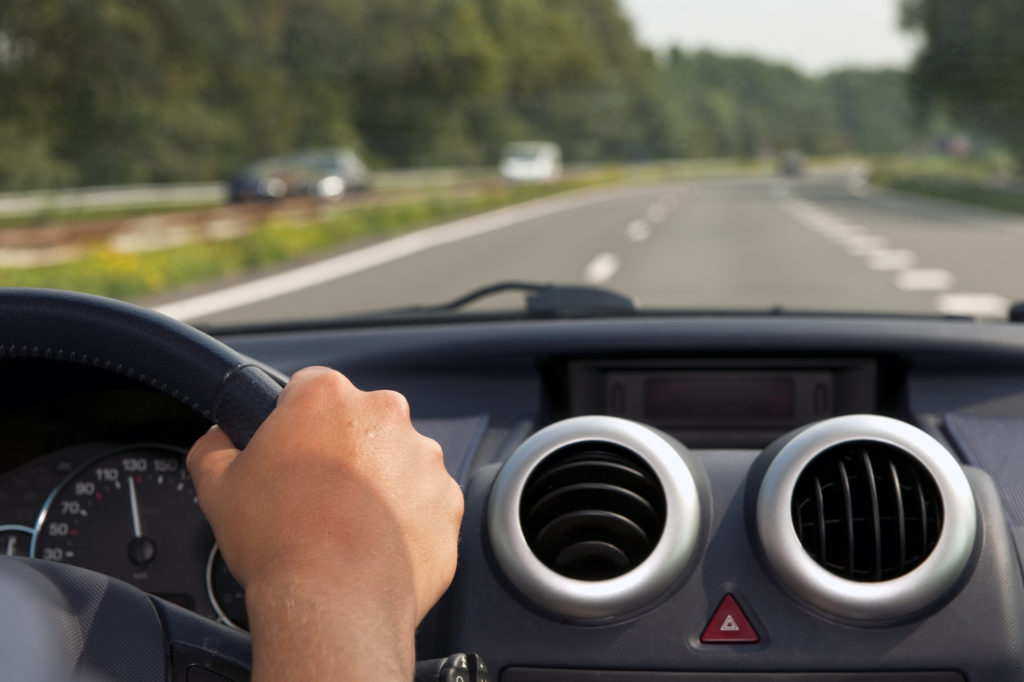
Symptoms of bad cruise control switch
- Symptom 1 — brake pedal does not disengage cruise control
There’s a switch fixed to the bases of the brake pedal and if cruise control does not deactivate when braking then it’s a sign that this switch is faulty.
- Symptom 2 — Hissing noises are heard from under the dash.
The cruise control switch is a vacuum system and for some vehicles, it is mounted near the brake pedals under the dash. If you can hear hissing, it could indicate that the switch or one of the switch’s vacuum hoses is broken.
- Symptom 3 — The cruise control switch/button itself does not work
When trying to turn on the function or while cruising it turns off, this is an indicator of a faulty switch and can be related to wiring issues or the above (1-2) symptoms
- Symptom 4 — A blown fuse
A blown fuse could be a simple error and fix. The switch circuit or fuse may just need to be replaced for the problem to resolve.
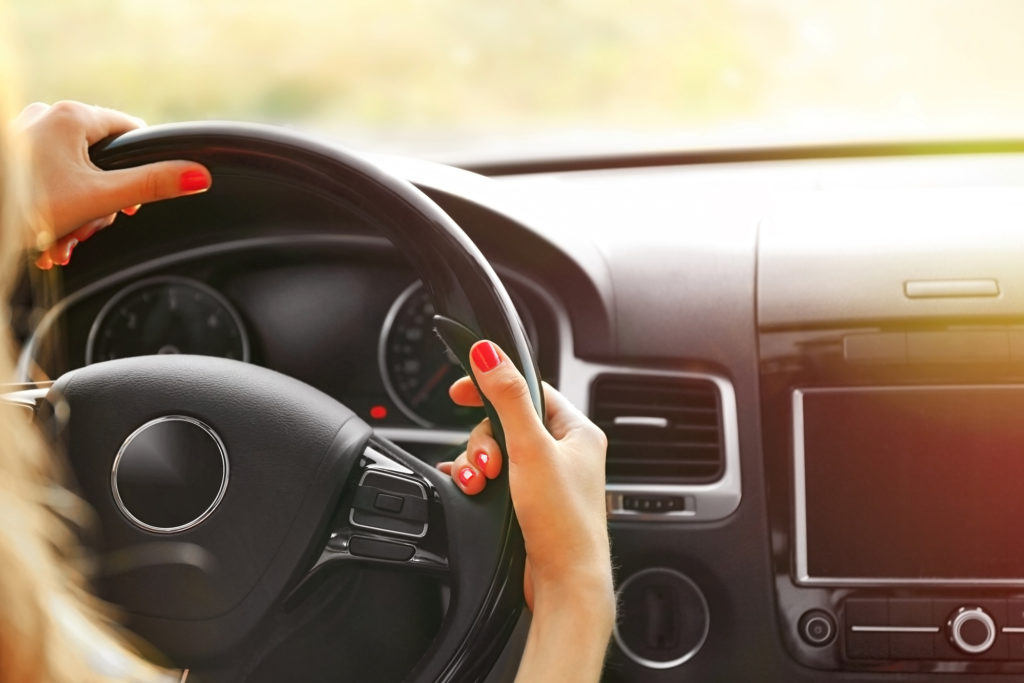
Possible Cruise control failure Scenarios
1. Cruise control not working after battery change
- Possible cause — This differs from vehicle to vehicle and among brands. Some drivers’ cruise control malfunctions after jump-starting their battery, and this is because the battery is still discharged. Newer cars have many electronic systems, and most are powered by the battery. So, if the battery is discharged or low-powered, the electrical cruise control system can be affected.
- Solution — Putting your battery on a trickle charger (2-5 amp) for 12 hours or driving on cruise for a couple of hours may resolve this issue.
2. Cruise control turns off while driving
- Possible cause — Damaged speed sensor or actuator, these two could be internally malfunctioning and causing the cruise control to disengage without input from you.
- Solution — Have a technician or mechanic run a diagnostic with the speed sensor and check the actuator hoses and cables.
3. Cruise control works intermittently
- Possible cause — this may relate to the brake pedal switch. If cruise control is intermittently disengaging, it could be a wiring issue with the switch.
- Solution — Have the brake pedal to cruise control switch investigated by a mechanic or technician and determine if there is a faulty wire to blame. You may need to have the switch or some of its parts replaced.
4. Cruise control turns on but will not set
- Possible cause — The brake pedal switch may be the issue. The brake pedal deactivates cruise control and if it is stuck in the open position, it may cause the cruise control to not engage or set properly.
- Solution — Ask your mechanic or technician to check for this issue specifically in their diagnostic and service.
5. Cruise control turns on by itself
- Possible cause — There may be a failure with the Electronic Control Module (ECM) which manages the actuators or Electronic Control Unit (ECU) which controls the speed in your cruise control
- Solution — You could attempt to reprogram the ECU and ECM if you have the computer tools, otherwise take it into a trusted mechanic or technician.
There are many helpful forums run by mechanics and amateurs: These are always great for solving those specific problems you might experience.
When CC does not set: https://mechanics.stackexchange.com/questions/34795/cruise-control-will-not-turn-on-cannot-be-enabled-nor-set
When CC is faulty after battery change: https://www.vwvortex.com/threads/help-cruise-control-not-working-after-dead-battery.4464553/
For cruise control and other general repairs, watch this channel: https://www.youtube.com/channel/UCf2f4MeZzSksVMe1z3Lp3hw
Can cruise control cause check engine light?
When the check engine light or MIL (Malfunction Indicator Light) is on, the cruise control light may blink to signal that cruise control has been disabled. This is a safety control as the vehicle is programmed to not go on ‘autopilot’ should the engine or mechanical issue relate to the cruise control systems. If the error or fault is with the cruise control systems, then the MIL may be lit for that as well.
How much does it cost to fix cruise control malfunctions?
- For switch repair (parts and labour) it’s estimated at $125- $350
- For fuse repairs, it could be up to $10 to buy the fuse and replace it yourself in a few minutes — there are many helpful YouTube tutorials on simple car repairs like this one.
- For actuator repairs, some cost more than $700
- Therefore, it’s important to know WHAT the issue is to get an idea of HOW MUCH it will cost you.
Does cruise control malfunction trigger the check engine light?
The function of a check engine light or MIL (Malfunction Indicator Light) is to communicate engine or mechanical failures in your vehicle to prevent an accident on the road. The MIL can be lit for simple reasons like the gas cap is loose. Should your CC system fail or run incorrectly, the MIL could light up. Often when there are other failures or engine faults, the MIL will light and the cruise control with a flicker to signal it has been disabled for safety reasons. Once the cruise control or other issues are fixed, all the lights should go back to being turned off.

Author: Dave Johnston
Related articles.
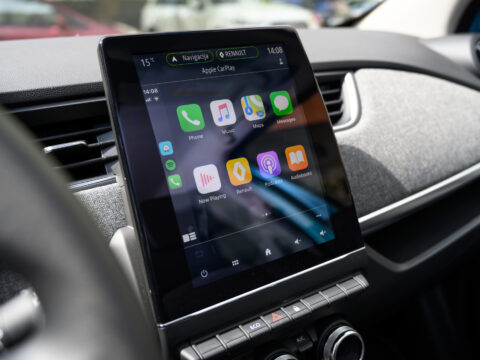
Leave a Reply Cancel reply
Your email address will not be published. Required fields are marked *
Save my name, email, and website in this browser for the next time I comment.
Recent Posts

MyCarMakesNoise.com
Copyright © 2024 My Car Makes Noise
Cruise Control Not Working? 9 Potential Causes
gabrieletamborrelli / Getty Images
- Cars & Motorcycles
- Frugal Living
- Fine Arts & Crafts
- Card Games & Gambling
- Playing Music
Cruise control reduces stress and fatigue on long drives, but if the system isn't working properly, it can become dangerous. If your vehicle's cruise control isn't working, one of the following nine issues may be the root cause.
How Cruise Control Works
Cruise control is a system to maintain vehicle speed without direct driver input. When you want to engage cruise control, you first turn the system “On” with a button or switch. However, this alone does not start the cruise control. When you “Set” cruising speed, the cruise control module (CCM) records the current speed, then takes control of the throttle body to maintain vehicle speed. When vehicle speed increases or decreases (due to wind or hills, for example), the CCM decreases or increases throttle body opening accordingly.
By modulating engine speed, the CCM can maintain your desired cruising speed on the highway. You can increase or decrease cruise speed by tapping a button or lever, and you can cancel cruise control by hitting the “Cancel” or “Off” buttons or stepping on the brake.
Throttle body control has changed over the years. Early systems used a vacuum motor and cable, but these eventually changed over to electric motors. Most recently, with the development of drive-by-wire or electronic throttle control systems (ETCS), cruise control is built into the engine control module (ECM), which controls the throttle body electronically.
Basic cruise control systems still require the driver to pay attention to changing road and traffic conditions. Adaptive cruise control systems, sometimes called "smart" cruise, use radar or laser detection to maintain safe distances from vehicles ahead. Some adaptive cruise control systems merely reduce engine speed to maintain distance, but some of the newest adaptive cruise control systems can also engage the brakes to slow or stop the vehicle. Still, even with adaptive cruise control, it's important that drivers never take their eyes off the road.
Why Is My Cruise Control Not Working?
There are a few basic ways that cruise control can fail, depending on how the system is designed. You may not be able to do much about ETCS cruise control systems, but there are a few things you can check:
Brake Light Switch – As cruise control is automatically cancelled by depressing the brake, some vehicles may disengage cruise control if it cannot detect the brake light switch.
Brake Lights – In some systems, cruise control is disabled when a brake light is blown. Aftermarket lighting, such as LED brake light conversion, might trick the CCM into thinking a brake light is blown, as LED bulbs draw less current than incandescent bulbs.
Fuses and Relays – On some vehicles, fuses and relays are used to protect the cruise control actuator circuit . If the fuse is blown or the relay is faulty, the system won’t work.
Spiral Cable – Many vehicles mount the cruise control switch on the steering wheel. A faulty spiral cable may have an open circuit, preventing the switch from contacting the CCM.
Control Switch – If the internal contacts wear out, the cruise control switch may not be able to contact the CCM. This might disable cruise control completely, or it might not react to the cancel or accelerate functions.
Check Engine Light – On some modern vehicles, particularly those equipped with ETCS, cruise control may be disabled if there is an engine or transmission problem .
Vacuum Leak – Some older vehicles used vacuum actuators to control the throttle body during cruise control operation. If there is a leak, such as a cracked hose or tube, the system won’t work. A vacuum leak might cause the engine to idler higher or set a fuel trim code.
Vehicle Speed Sensor – There are usually multiple vehicle speed sensors (VSS) on any given vehicle. The CCM might use a VSS feed from the ECM, instrument cluster, or transmission. If that signal is lost, the CCM can’t detect vehicle speed, disabling cruise control.
Electrical Problems – As most cruise control systems use electrical or electronic components, any diagnosis should include a thorough check of source voltage, wiring harnesses, and connectors. Anything loose or broken could disable the system entirely.
If your cruise control isn’t working properly, avoid using it until it is repaired. A faulty cruise control system may not cancel on demand, which will create a safety hazard for you and those around you. After assessing your cruise control yourself, take your vehicle to a trusted mechanic for a check or a couple diagnosis and repair.
- Troubleshooting Idle Problems in Mazda Engines
- 9 Reasons Your High Beam Headlights Are Not Working
- How to Replace a Vehicle Speed Sensor
- How Electronic Throttle Control (ETC) Works
- What Does This Exhaust Color Mean?
- Troubleshooting Engine Driveability Problems: Surging or Misfiring
- Why Are My Wiper Blades Smearing the Windshield?
- Troubleshooting a No Spark Problem in Honda Accord
- How the Air Intake System Works
- 1999 Era Volkswagen Jetta Fuse Map
- Reasons Why Your Car's Idle Speed Might Be Too High
- Is Your Car Idling Too Rough?
- Troubleshooting Engine Oil Consumption
- K&N Million-Mile Air Filter Review
- How to Clean the ABS Wheel Sensor on Your Car
- Diagnosing a High Idle Problem on a Nissan Truck

- Broken Down?
- Car Breakdown Cover
- Electric Car Breakdown Cover
- Van Breakdown Cover
- Business Breakdown Cover
- Motorcycle Breakdown Cover
- Classic Car Breakdown Cover
- Personal Breakdown Cover
- Short Term European Breakdown Cover
- Misfuel Cover
- Motoring Advice
- Vehicle Recovery
- Mobile Apps
- UK Accident Assistance Service
- Corporate Social Responsibility
- Which? Recommended Provider
- 5 Star Defaqto Breakdown Cover
- Award Winning Breakdown Cover
- Frequently Asked Questions
- Travel Insurance
- Bicycle Insurance
- Home Insurance
- Motorbike Insurance
- Car Insurance
- Alloy Wheel Insurance
- GAP Insurance
- Pet Insurance
- Latest Stories
- Customer Lounge
- Business Lounge
- Looking for Business Cover?

- Breakdown Cover
- Car Servicing and Repairs
10 potential reasons why your cruise control is not working
What is cruise control.
Cruise control is a way of maintaining a selected constant speed without needing to use the accelerator pedal. It is closely integrated with the traction control and braking systems.
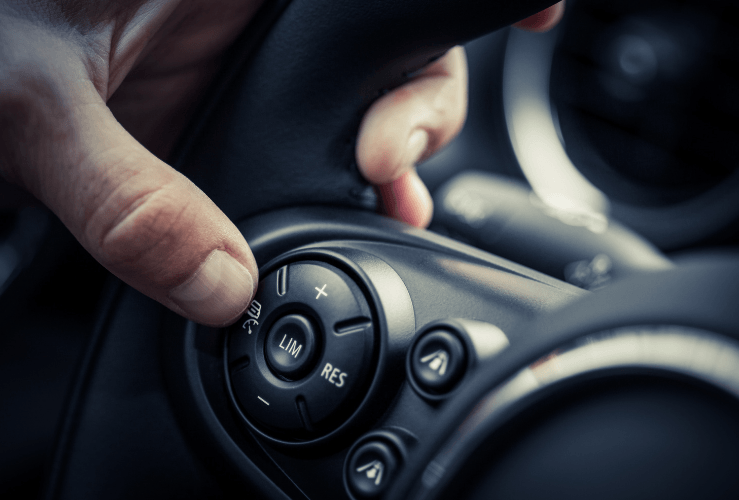
How do I know if my cruise control is not working?
Cruise control systems have become steadily more complex over time. This means it's not always easy to pinpoint why a cruise control system is not working - especially in newer models.
What happens if my cruise control stops working?
While cruise control can make long journeys easier and less stressful, if the system fails it can be dangerous. For example, it may not be possible to cancel a faulty cruise control system - which could have dire consequences. So if your cruise control only works sometimes, or not at all, avoid using it until you can find a solution - by taking it to a trusted mechanic. Alternatively, you may decide to research the issue and attempt to fix it yourself. However, the safest option is to take it to a garage.
Note: You should always check your vehicle handbook for any fault remedy before carrying out any work on your vehicle. If you are unsure of what is required to fix any problems, please consult a professional.
In this article we'll look at 10 of the most common reasons for a malfunctioning cruise control system.
How do cruise control systems work?
Before we begin, it's important to understand how cruise control systems work.
You must first activate the system by pressing the cruise control 'on' button - normally located by the steering wheel. However, this does not activate the system by itself.
Once you've set the cruising speed, the cruise control module (CCM) notes the present speed, then takes over the throttle body to maintain the speed of the car.
As the vehicle’s speed increases or decreases (due to inclines, for example), the CCM makes adjustments to the throttle body opening.
The desired cruising speed is maintained by modulating the engine speed. This speed can be adjusted, or cruise control can be cancelled by pressing 'cancel' or 'off'. The system is also cancelled if the driver applies the brakes.
Paying attention on the road
Cruise control systems are available with varying levels of complexity.
Aside from basic cruise control systems, ‘adaptive cruise control systems’ are often fitted with radar for maintaining safe distances between vehicles behind and ahead. Some even control engine speed in response to nearby vehicles.
Whichever cruise control system your car has, it's critical you still pay attention to other road users in order to avoid collisions. Cruise control should not be considered a fully ‘autonomous’ driving system.
Electronic throttle control systems (ETCS)
With electronic throttle control systems, cruise control is integrated with the engine control module (ECM). These are also known as 'drive-by-wire' systems because of their semi-autonomous nature.
Note that ETCS system failures may require the attention of a trained mechanic.
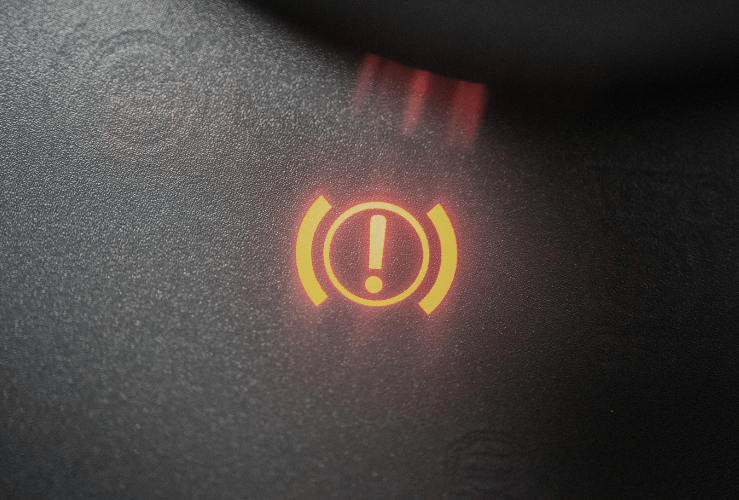
What are the top reasons for cruise control failure?
Brake light switch fault.
Cruise control systems will not activate if they cannot detect a working brake light switch. This is because cruise control systems automatically cancelled once the brakes are applied.
How do you repair a break light switch fault?
If you have some understanding of car mechanics, you may be able to examine the brake light switch, which is located below the steering wheel. However, because such systems have multiple wires, it can be difficult to identify any fault.
You may decide to invest in a multi-application service tool/OBD scanner, which can plug directly into your engine’s computer and pinpoint any fault with your brake light switch.
However, rather than spend money on an OBD scanner and learn how to use it, many people simply replace the brake light switch. Many aftermarket brake light switch replacements are available.
Cruise control switch function: worn out
It's possible for a cruise control switch to wear out over time by being pressed too much or too hard. It may also get damaged by drink spillages or by solvent used when cleaning the steering wheel.
This could mean the CCM cannot be communicated with, potentially disabling cruise control entirely.
How do you check if the cruise control switch function has worn out?
You may be able to confirm this is the issue with an OBD scanner. However, you can check this by looking to see if the cruise control light appears on the dashboard when the switch is operated.
Brake light issues
Some cruise control systems will not activate if they detect a blown brake light. Some aftermarket LED lights draw less current than factory-new lights, which can make the cruise control think a light has been blown.
Spiral cable fault
The spiral cable connects electrical circuits in the steering column to elements in the steering wheel - such as the cruise control activation button. If the spiral cable has an open circuit, the switch may be unable to communicate with the CCM.
Check engine light
Engine or transmission problems may automatically lead to the disabling of cruise control - especially if it's of the ETCS type.
Fuses and relays
The cruise control actuator circuit may be protected by fuses or relays. If these are blown or damaged, the cruise control system may not activate.
Vacuum leak
On some older cars vacuum actuators are used to manage the throttle body when cruise control is activated. A cracked tub or shoe could result in a leak, preventing the system from working. It might also make the engine idle higher.
Vehicle speed sensor fault
The modern car often has multiple speed sensors. If the ECM speed sensor signal used by the CCM is lost, cruise control will not work.
ABS sensor faults
If any of the ABS sensors are faulty (there is normally one on each wheel), the cruise control system will not activate.
Electrical problems
Electrical components are integral to cruise control systems, and should therefore be thoroughly checked in the event of a fault. Issues with source voltage, connectors and wiring harness could disable the system.
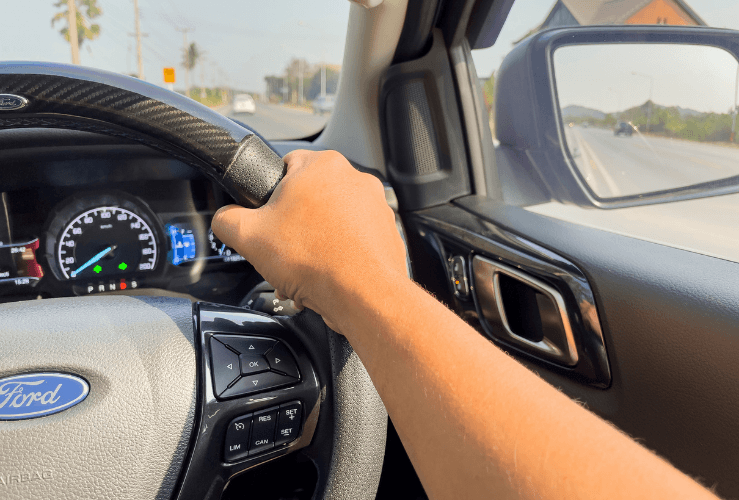
Credit: xzotica65 - stock.adobe.com
Ford cruise control not working?
If the cruise control system on your Ford is not working, the most likely culprits are still those listed above. However, experienced Ford mechanic “ Build It Make It ” on YouTube argues that burned out brake lights are the most common reasons for cruise control failure - especially on models such as the Ford F150.
The next most common reason for faulty Ford cruise control is a blown fuse . Fuses can be checked with a multimeter if you have the required experience, and then replaced.
Build It Make It then lists a broken brake light switch as being the next most common reason. A faulty shifter actuator is listed as the next most common fault cause. This is a lock to ensure you’re not gear shifting when you don’t have the brake engaged. Since the car cannot detect which gear you’re in, it will deactivate the cruise control as a safety measure.
And the fifth most common reason for Ford cruise control not working is faulty control switches . Unless you have extensive automotive mechanical experience, it may be best to have your control switches replaced by a trained Ford mechanic.

More possible Ford cruise control fault reasons
Auto Repair Guys on YouTube list the following as common reasons for Ford cruise control not working:
- Faulty cruise control fuse (often located under glove box) Note: newer Fords may not have fuses for cruise control
- Faulty control switches
- Faulty brake light switch (sometimes integrated with the cruise control switch)
- Faulty ‘cork spring’ or ‘spiral cable’ - as mentioned this connects the steering wheel controls to the car’s computer.
- Motoring Developments and The Future
- Fuel Types and the Environment
- Safety and Security
- Weather and Seasons
- Breakdown Advice
- Driving In Europe
- Tips on Choosing Breakdown Cover
- Motoring Costs
- In-Car Games
- Motorcycling Advice
- Car engine noises you shouldn't ignore
- Warning signs your catalytic converter is failing
- Is mobile tyre fitting as good as in a garage?
- How much does it cost to change a tyre?
- What are the signs your clutch needs replacing?
- Broken coil spring symptoms: Can I still drive my car?
- What is An Air-Con Bomb and How Do You Use One?
- Car won't start? Here are common causes and solutions
- When and How to Check Your Car Brakes
- Car servicing: Is using a dealership worth it?
- What is ABS? The Anti-lock Braking System Explained
- Car rust: How to repair and prevent it – Complete guide
- What do I do if my car is juddering?
- Catalytic Converters: What Does a Catalytic Converter Do?
- How much does it cost to replace brake pads?
- Car coolant leaks: What are the signs?
- What is an ECU?
- Car battery maintenance: How to keep your battery in good condition
- Regassing your car's air-con: Complete guide
- Top reasons your engine management light is on
- Drink Drive Limits: All You Need to Know
- When should you replace your car shock absorbers?
- Car leaking fuel: Common causes and fixes
- The signs and dangers of a faulty exhaust
- How to prevent voiding your car’s warranty
- How to Reset your Engine Management Light / Check Engine Light
- Car oil leaks: Why they happen and how to fix them
- How far can you drive an overheating car?
- Where do you put antifreeze in your car?
- Low car oil symptoms not to ignore
- Car air conditioning: tips and tricks for super-cool AC
- Car engine oil check: How to do It and when
- How to repair the roof of a convertible car
- Can you tint front windows? How to do window tinting legally
- Tyre bulges: The dangers they pose - and how to fix them
- 10 signs your gearbox is failing
- How to choose a towbar?
- How to repair a paint scratch yourself
- How to change car bulbs: Headlights, indicators and brake lights
- Should I repair or sell my old car?
- I've put the wrong fuel in my car: what should I do?
- How to use a car tyre puncture repair kit
- How to Fit a Tow Bar
- Car tyre size explained
- How to change a car battery
- Car parts: Buy from an authorised dealer or independent garage?
- Is it worth converting a classic car to an EV?
- Common car body shapes: a crash course
- How to check your tyre pressure
- How much oil does my car take?
- Diesel Particulate Filter (DPF) maintenance
- How much is an mot? MOT costs in UK
- Spring cleaning your car
- Head Gasket Guide | Head Gasket Repair UK
- What type of oil does my car need?
- What does brake fluid do and how you can change it yourself
- Blown Turbo Symptoms
- Water is leaking from under my car: What should I do?
- 10 tips for avoiding costly MOT repairs
- Why is my car stalling?
- Timing belt: What does it do? When does it need changing?
- 9 common reasons for failing an MOT
- MOT guide: Common questions answered
- Does breakdown cover include punctures?
- What do Cat C and Cat D mean?
- Keeping your suspension in good shape
- Why does my car smell of petrol?
- How often should you service your car?
- 5 car repairs you shouldn't tackle yourself
- Flooded petrol engine: How to fix it
- How to Fix Your Leaking Sunroof
- My car is stalling: How do I fix it?
- Air conditioning fault: How to fix it yourself
- DIY puncture repairs: a complete guide
- Cloth or leather car seats: Which are right for you?
- How to transfer a private number plate to your car
- How to take care of your clutch
- Car radiator leak – How to fix
- Car radiator leak – what do you do?
- Paint protection film (PPF) for your car: is it worth it?
- How to install new car front seats: quick guide
- What is a wheel bearing and why is it important?
- Dashboard warning lights: a quick guide
- Why does my car judder when I brake?
- What are run-flat tyres?
- What size engine do I need?
- Damaged windscreen? Here’s why you should fix it promptly
- How much is an MOT test?
- Choosing the right engine oil: A quick guide
- When should you replace your fuel filter?
- Antifreeze - what it does and which you should use
- What is wheel alignment?
- How to remove the smell of cigarette smoke from your car
- MOT: is your vehicle exempt?
- When to change your car battery
- Does your car need a spring clean?
- How to look after your engine
- How to increase the life of your car
- Potholes: How to avoid damaging your car
- Everything you need to know before buying and changing oil
- The benefits of car servicing
- What causes battery problems in winter?
- Ways to clean your car headlights
- When to change your timing belt
- Keeping a tool box in the car: What to carry
Get a Quote

I received a rapid response and repair which got me on my way without issue. The recovery service who attended was polite and reassuring and the contr...
Excellent service..easy to contact. Very courteous and arranged technician promptly without quibble. Technician arrived within hour and fixed car with...
Skill and helpfulness of Ryan - Highfield Garage technician.
Good response, we actually broke down on Bank Holiday Monday so had to have the car recovered back home Very prompt service, rescue guy very accommoda...
You can always rely on Start Rescue, fast, expert and great guys who turn up to get you back on the road
Excellent service! Call operator, polite and thorough. I received a text telling me the time my help would arrive and he arrived within the hour (30 m...
Breaking down is a stressful situation and the service given by Start Rescue was exemplary, not only were their timings spot on and to call 3 times to...
It’s well worth going with this company, I was kept updated every step of the way, if the breakdown company didn’t arrive on time they were contacted ...
Very quick repair
I recently had a tyre blow out whilst travelling on the M62 over the Pennines and had to pull over onto the hard shoulder. Very scary! I used the Smar...
Cookies Policy
We use essential cookies to ensure our site is safe and works properly. We also use analytics cookies to offer you a more personalised experience and to improve our site. To find out more and manage your cookie preferences, please choose ‘Manage’ or view our cookies policy.
This Cookies Policy sets out how startrescue.co.uk (“We”), use cookies on this website.
About Cookies
A cookie is a small file that is downloaded to a device (e.g. a Computer, Tablet or Smartphone) when a website is visited. The cookie allows the website to recognise a user’s device and store information based on the user’s previous actions and preferences.
For a complete definition of cookies, please visit the Information Commissioner’s Office (ICO) website here .
Essential Cookies
The table below explains the essential cookies We use and why.
The table below explains the analytics cookies We use and why.
Information on controlling cookies using specific web browsers can be found on the Information Commissioner’s Office (ICO) website here .
Any changes We may make to Our Cookies Policy in the future will be posted on this page. We advise that you check this page regularly to keep up to date with any necessary changes.

7 Reasons Why Cruise Control is Not Working
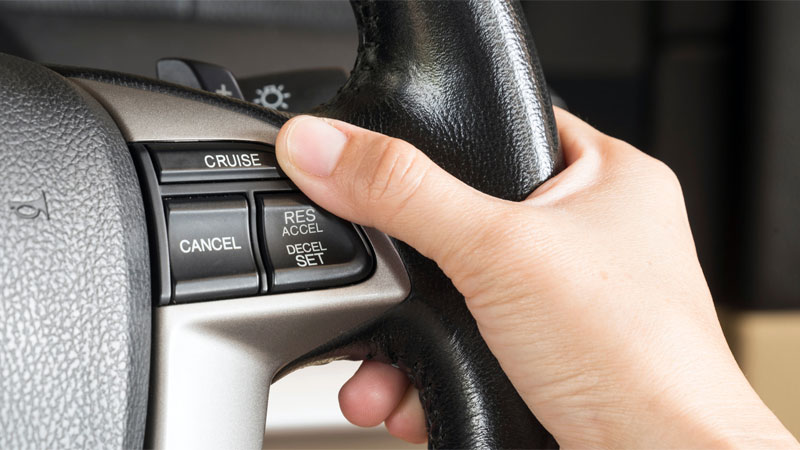
Cruise control has been around since the late 1950s. There was a time when you could only find this convenient feature in a few model vehicles. Nowadays, it seems like virtually every model vehicle on the road has a cruise control feature.
Cruise control not engaging seems like a trivial issue, but the inability to activate this convenient feature can certainly dampen any road trip. While cruise control failures “rarely” pose safety risks, determining the root cause is necessary to restore its use. Let’s look at the common causes of cruise control malfunction.
Table of Contents
Cruise Control Problems (Accelerating or Maintaining Speed)
If your cruise control feature malfunctions and stops working altogether, you may not think it’s an immediate concern. You’ll probably figure that you just can’t use cruise control anymore until you get the problem fixed.
However, the problem with your cruise control might be related to an acceleration issue too. In fact, there are components of cruise control which can have an adverse effect on the acceleration if those components are bad. That is why you need to be aware of what causes cruise control issues.
Common Causes of Cruise Control Not Working
There are several possible causes of cruise control not working. Below are the top 6 most common causes. Check each of these areas and see if they’re the cause of your cruise control issue. In many cases, the remedy to the problem is not that complicated or expensive.
1) Cruise Control Switch

The cruise control switch is what you use to set your cruising speed. This information is transmitted to the engine control unit and cruise control module in order to sustain the acceleration speed.
If the contacts inside the cruise control switch were to wear out, then the module and unit might not receive the necessary speed information it needs to keep the acceleration going. In response, the system will deactivate entirely and cancel the current cruise acceleration set.
2) Brake Light Switch
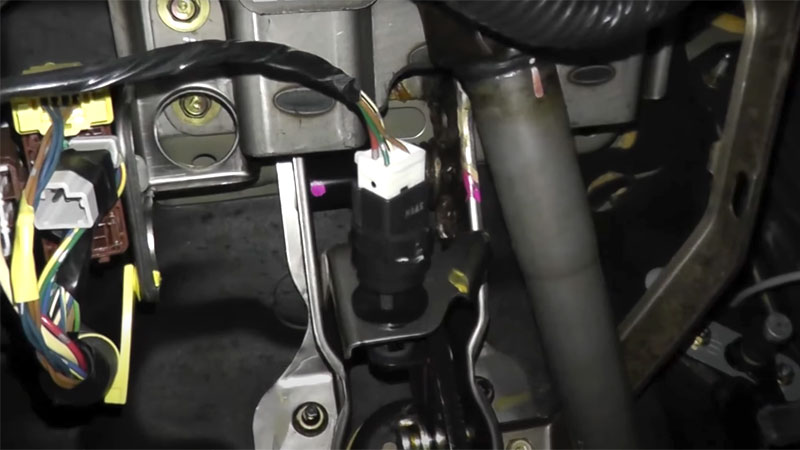
Normally, you press the brake pedal to turn off cruise control. The brake light switch must be detected by the cruise control system for this to happen.
If it cannot detect the switch, then cruise control will disable itself automatically until the brake light switch issue is fixed.
A faulty brake light switch can also cause your brake lights to stay on .
3) Blown Fuse
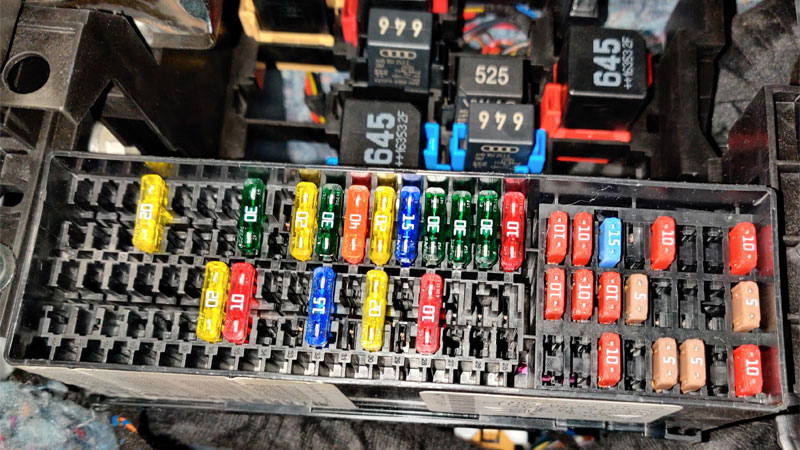
The electrical components of the cruise control system are protected by fuses. Like inside your house, it is possible to blow a fuse. This will cause the cruise control system to turn off until the fuse is replaced.
4) Check Engine Warning Light
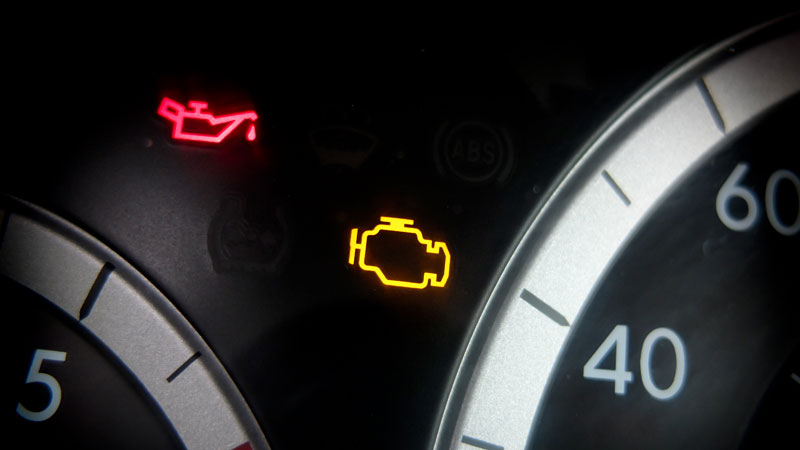
If the check engine warning light comes on, it usually means there is a problem with your transmission or engine. Once the engine control unit detects this problem, it may disable your cruise control system in response as a safety precaution.
Until you fix the engine issue, the cruise control will stay disabled.
5) Vehicle Speed Sensor
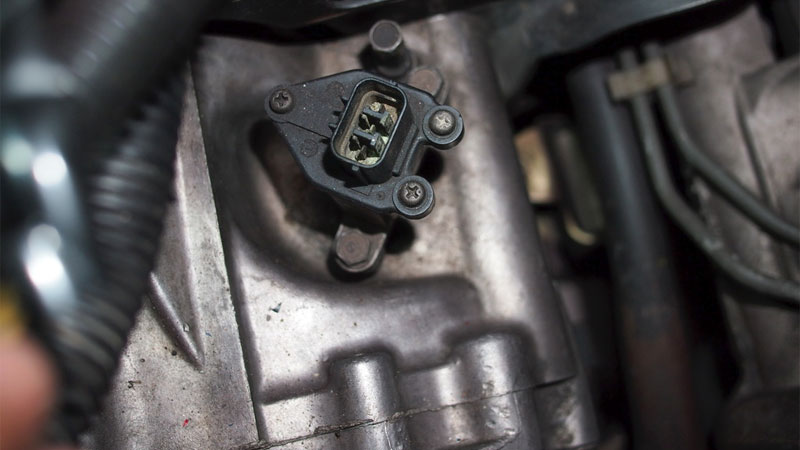
Most vehicles have a few vehicle speed sensors to transmit speed information about the vehicle to the engine control unit and the cruise control module. The only way your cruise control module is going to know how fast the vehicle is moving is if the vehicle speed sensors feed this information to it.
If the module cannot detect the speed because of faulty speed sensors, then the cruise control system will automatically deactivate.
See Also: What Is Speed Volume Compensation?
6) Electrical Issues
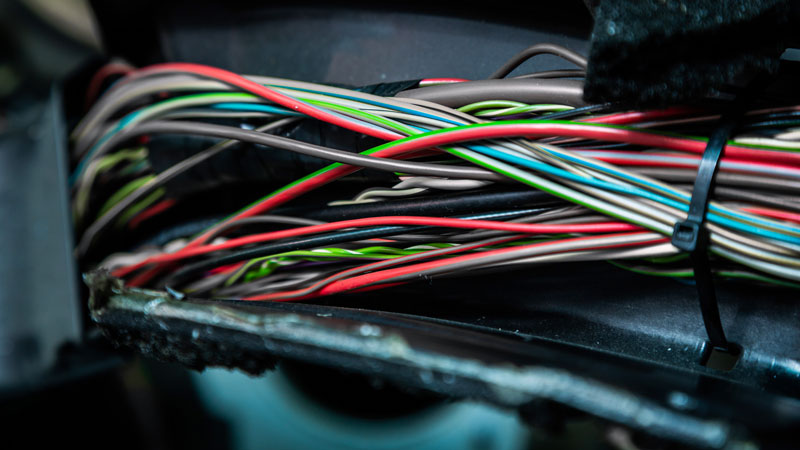
There are several electrical components connected to the cruise control system. The connectors and wiring harnesses, and ground straps are definitely components that you need to check when the cruise control stops working.
Make sure the source of the voltage is still supplying power to the system as well. If any of these components are loose or damaged, then it would explain why the cruise control isn’t functioning.
7) Loose or Broken Cruise Control Cable
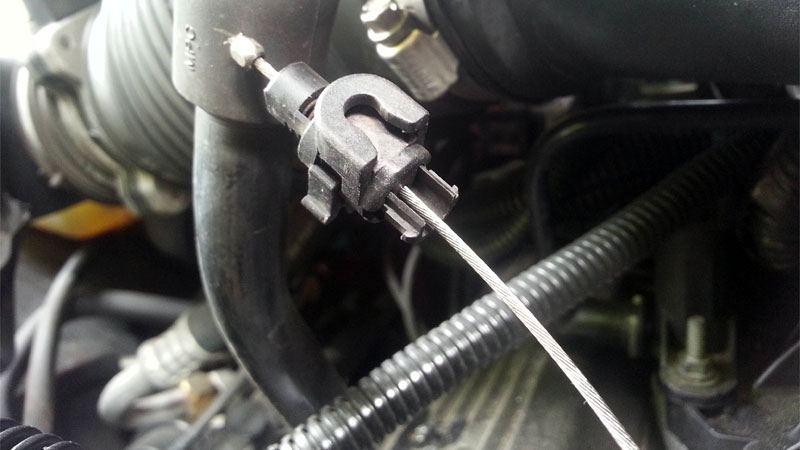
Older vehicles that are equipped with cruise control have two throttle cables – one for the gas pedal and one for the cruise control system.
These cables may stretch over time. If the cruise control cable has stretched or is broken, the cruise control system will not be able to operate the throttle plate properly.
Adaptive Cruise Control Specific Problems

Adaptive cruise control gives an extra layer of convenience while driving, as it adjusts your vehicle’s speed based on the distance to the car in front of you. However, this presents additional causes of cruise control failure.
One issue you might face is obstructed sensors. Both radar and cameras are important components of the adaptive cruise control system. When there’s dirt, debris, or ice covering these sensors, your cruise control can stop functioning. To prevent this, regularly clean your vehicle’s sensors, making sure they’re unobstructed.
Separately, failed cameras can also be a culprit. If the cameras aren’t working correctly, you may see an error warning. It’s best to get this checked by a professional to determine whether the cameras need repair or replacement. Hopefully it’s not as they are an expensive replacement.
Apart from cameras, adaptive cruise control relies heavily on radar technology for proper functioning. A misaligned or malfunctioning radar sensor can cause your system to behave irregularly. Again, consult a qualified technician to diagnose the issue and, if needed, recalibrate or replace the radar system.
Safe Driving Without Cruise Control
When cruise control systems fail, it presents challenges adjusting to speed management without the consistent pacing it provides. But there are a few things you can do.
- Focus on scanning gauges more frequently to stay actively aware of mph.
- Avoid zoning out on long hauls.
- Set phone alerts every few miles to remind checking current travel speed.
- Know highway speed limits well so mentally benchmarking against them continues subconsciously.
- Take frequent breaks stretching legs to re-energize alertness until able to diagnose cruise faults.
- Consider alternative adaptive cruise technologies equipped on newer vehicles if financially viable, providing automated incremental slowing when closing distances on lead cars.
- Remain vigilant of lead car distances and your own speed fluctuations.
- Utilize open lanes with fewer surrounding vehicles if possible, reducing needs for continual minor adjustments.
- Stay alert with renewed attention and defensive awareness absent cruise controls automated convenience until repairs are completed.
Intermittent Fault Identification
When cruise controls experience occasional yet repeating failures, meticulously logging every instance of malfunction helps uncover patterns guiding toward root causes.
Date and time each cutoff or disengagement that happens while activated. Detail any environmental or operational conditions present such as: weather, bumpy vs smooth roads, stop & go traffic versus highway speeds.
Reviewing complete repair histories alongside these event logs indicates if previously replaced components only provided temporary fixes before subsequent re-failure later on. Share documented patterns of when and how interruptions occur with shop technicians to guide their pathway tracing and component testing.
The goal is determining if specific elements like an old switch, wire insulation or solder joint chronically breaks down only under certain temperature, vibration or usage strain thresholds.
Cruise Control Repair Costs
So, your cruise control decided to take a break, and now you’re wondering how much it’ll cost to fix it. Well, repair costs vary depending on the specific issue and your vehicle’s make and model. This section will provide you with an idea of what to expect in terms of expenses.
Let’s look at the common reasons for cruise control problems and their approximate price range for replacement or repair:
- Faulty Cruise Control Switch – $100 – $200. A bit more expensive than a brake light switch.
- Blown Fuse – $5 – $30. Quick and affordable to replace.
- Faulty Brake Light Switch – $50 – $150. Can be a bit pricier but still manageable.
- Defective Speed Sensor – $100 – $300. Falls somewhere in the middle of the price spectrum.
- Throttle Control System Issues – $200 – $600. More expensive to diagnose and fix.
- ABS-related Problems – $200 – $1,000. Can also be quite costly to repair.
- Broken Vacuum Line – $50 – $150. Applicable to older systems and typically inexpensive to fix.
How Does Cruise Control Work?
If you normally drive long distances, especially on the interstate, then cruise control lets you take your foot off the gas while the car maintains the same speed, giving your leg a rest. This may seem like merely a luxurious feature rather than a necessity, but many people depend on it for safe driving.
There are several different types of cruise control systems, but all implementations share similar basic components. There is a sensor to measure vehicle speed, a throttle position sensor , and some mechanism to control the throttle plate without the use of the gas pedal.
Outputs from the speed and throttle position sensors allow the engine computer to determine how much the throttle plate needs to open or close to maintain speed.
Cruise control systems may also use sensors in the transmission, taking the current gear and engine vacuum into account. Throttle position will be different in each gear at a given speed, especially when driving over hills.
Related: How Does Drive-By-Wire Technology Work?
- Recent Posts
- Power Windows Not Working? (10 Common Causes and How to Fix) - February 8, 2024
- 14 Causes of a Car Losing Power When Accelerating - January 23, 2024
- 13 Causes of Poor Gas Mileage (Increase Your MPG) - December 13, 2023
14 thoughts on “7 Reasons Why Cruise Control is Not Working”
My 2003 GMC Envoy has a cruise control issue that I can’t find a fix for anywhere. When I first crank the car and head down the road the cruise control will not engage. But after driving a mile or so, depending on how cool the weather is, I can turn the engine off and re-crank it. Then the cruise control works. On cooler temps it may take two or three restarts for it to engage. Ideas???
have a 2006 VW new Beetle my cruise works fine until i go to pass some one ,any idea what would cause it to do this? ?
When you hit the gas pedal to overtake, you might be disengaging cruise control.
i’ve heard that bad fuel can create such issue. As stated above, the Check Engine light will come on as part of the safety features to inform you something is not right. Cruise control picks up on this and shuts down.
The engine light was flashing then it stopped then started again, the cruise control is disabled but did come on a couple of times but went off when the engine needed to accelerate, the engine shakes when I. Accelerate too.
my aftermarket cruise on a 2013 Kio Rio LX wont light up
You’re going to have a hard time with finding help for that without providing the name and model of the aftermarket system. It might be best to take it to someone so they can troubleshoot in person.
My cruise indicator light will turn on but when I try to set the speed the light will shut off and not turn back on until I restart the engine. Any ideas what it might be?
Did you ever figure this one out. I got 99 Durango does this too
Cruise control goes rite into high speed when turned on,what could the problem be?
This helped me a lot. I got more out of your 6 reasons a cruise control may not work, than when I inquired about the same situation and got nothing. Thank You, Janet M.
Thanks for the feedback, Janet!
Helpful. Thank you
Mine is a mercedes benz c180, 2002 model my cruise control have just stopped working . So what are the possible causes
Leave a Comment Cancel reply

- Why is my Cruise Control not Working? [14 reasons]
14 Reasons Why your Cruise Control may NOT Be Working
The reason for your cruise control not working could be as simple as a blown fuse to really complex electrical problems. Defective switches, sensors, and even “check engine” light, all could contribute to this problem.
If you like to travel and own a car fitted with cruise control, you know how comfortable it can be to maintain a constant speed! When a cruise control system gets damaged, it is just as annoying as it is dangerous.
Cruise control is connected to several components of the car, and when it fails it can mean that something could be wrong with the CC itself. It could also be a signal that something wrong is happening with any other component of the car.
Why is my cruise control not working?
In this article, I am going to show you the main reasons why your cruise control may not be working (from the simplest to the more complex ones):
Reason #1. Bad or blown fuse
The cruise control’s circuit (like many other electronic components of your car), is protected by a fuse that will blow to protect the system from short circuits and overloads. If your vehicle’s cruise control fuse is blown, the system will stop working.
You can replace the fuse with a new one of the correct amperage, according to your vehicle’s owner manual. If the new fuse doesn’t blow again, everything will be ok; if the fuse blows again, you have to keep searching for what is making that fuse blow.
Reason #2. Burnt brake lamp
Some cruise control systems are disabled when the brake lamp is blown. Check your brake lights. If you find a burnt brake light, just replace it and test the system again.
Reason #3. Defective brake light switch
A defective pedal switch can also make your cruise control stop working. Remember that all cruise control systems are automatically disengaged as soon as the brake pedal is pressed down.
If the cruise control didn’t stop working when a fault in the brake light or brake pedal switch is detected, it could be dangerous; that’s why the CC control unit constantly monitors the status of this switch.
Reason #4. Clutch pedal switch deactivation (for manual transmission vehicles)
Cruise control is deactivated when the clutch is pressed by the driver in manual transmission cars. The CC control unit monitors this switch as it does the brake light switch.
Reason #5. The vehicle speed sensor is not working
A vehicle’s cruise control needs to be able to determine the vehicle’s actual speed. This enables the system to determine how much throttle needs to be applied in order to keep a certain speed, among other things.
The speedometer speed sensor is not always the sensor used by cruise control. Some systems rely on the ABS speed sensors, others do an average and some have a dedicated speed sensor.
If the system can’t detect the vehicle’s speed or detects a problem with the speed sensor, it will stop working.
Reason #6. Faulty throttle body or accelerator pedal
In modern engines, the throttle body is driven electronically by the engine control unit (ECU), and the accelerator pedal works like a potentiometer. The processor managing the cruise control system will act as the accelerator pedal, sending more or less voltage to the throttle body to open or close the throttle body’s butterfly valve.
If there is a problem with your vehicle’s throttle body, your cruise control won’t work.
Reason #7. Check Engine light is “ON”
If your vehicle instrument panel has the “Check Engine Light” ON and the fault stored in the ECU’s memory is related to some component vital for the cruise control system, you will not be able to use your cruise control until you have fixed that problem.
Reason #8. Faulty steering wheel’s spiral cable/clock spring
The spiral cable connects all the switches from the steering wheel (in case your steering wheel has switches) to their respective modules. This includes the connection of the driver’s airbag.
These wires (also called clock springs) are prone to get cut. A faulty spiral cable may have an open circuit making it unable to reach the vehicle’s cruise control module (CCM).
Reason #9. Bad Cruise Control Switch
Your vehicle’s cruise control switches have internal contacts that wear out. If that happens, the switches won’t be able to contact the CCM.
Depending on which buttons are faulty, your whole cruise control can stop working or just some functions won’t work.
Reason #10. Electrical problems with different modules and wiring
Modern cruise control systems use electrical and electronic components, and they are connected to other modules and systems of the vehicle. Some of these systems are the ECU, ABS, and/or Stability Control Systems like ESP.
The CCM makes a check of these systems once the key is switched to ON, and if some of these components are not working in optimal conditions, the CCM won’t engage. If none of the above items seem to be the problem, the vehicle needs to be taken to a professional who can perform a full scan of all the components, check that all the voltages, wiring harnesses, and connectors are ok.
The professional is going to detect if there are any connection problems between modules and will be able to find the reason why the cruise control is not working.
Reason #11. Dirty or faulty camera or sensor (only for vehicles fitted with adaptive cruise controls)
Newer vehicles have adaptive cruise control systems. These devices not only keep a fixed speed by the driver; they also can detect other vehicles ahead and behind and are able to keep a safe fixed distance to avoid collisions.
Some of these new systems have laser sensors while others have cameras to calculate the right distance to follow considering the vehicle’s speed and acceleration. Any problem with the sensors will prevent adaptive cruise control from working.
Problems with older cruise control systems
Before electronic injection and electronic throttle bodies, some cars had the cruise control function. In fact, the first cruise controls were introduced in the early 1950s.
These electromechanical cruise controls are pretty simple. They have a vacuum actuator connected to the throttle linkage that opens and closes the throttle to maintain the vehicle’s speed.
In early injection cars, the throttle linkage was replaced by a cable. Some common faults of these old cruise control systems are:
- A faulty vacuum actuator. Vacuum actuators have a diaphragm inside that can break. Any vacuum leak will lead to failure.
- Faulty vacuum control solenoid. It can prevent the actuator from operating normally.
- Broken throttle cable. If the throttle cable or linkage is broken, it needs to be replaced.
I hope you enjoyed my guide to cruise control problems. Even though it doesn’t explain how to fix your cruise control, it gives you an idea of where to start looking if you are going to do it yourself.
Now you will have an idea about how the system works and what are the possible reasons why it’s failing (in case you have to take your vehicle to a shop to be repaired).
Attention! This article is for informational purposes ONLY and is NOT a replacement for professional advice! ALWAYS consult your local specialist for an appropriate solution to your problem. All statements, prices, contact information, recommendations, and reviews contained herein came from sources that we believe to be reliable, but the accuracy or completeness thereof is not guaranteed. Please contact the service provider for complete details and updates.

I always Know and admit that even though I went to school for ABR grad. In 1994 3.36gpa still have go go back to school for upgrades due to vehicle advancement but I still learned alot although I am dealing with an 05 f150 stx which has more recalls then a auto parts store where the employees don’t know a inerta. Switch from an ignition switch ,thanks for the information
Leave a Reply Cancel reply
Your email address will not be published. Required fields are marked *
Save my name, email, and website in this browser for the next time I comment.
Privacy Overview
Why Is My Cruise Control Not Working? 6 Common Reasons
By: Author Zach Reed
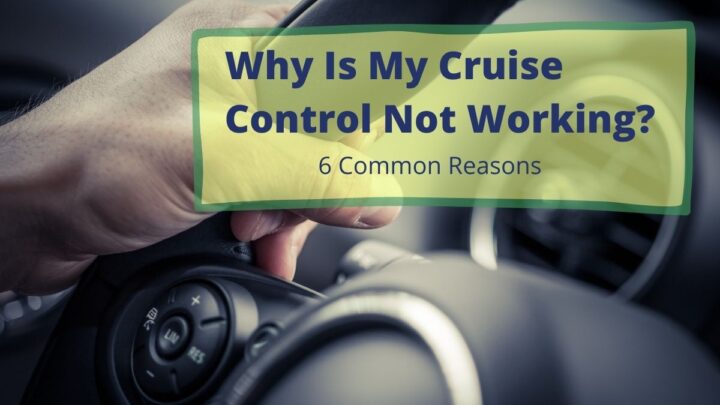
When your cruise control stops working, it can be quite an inconvenience. In this expert guide, we’ll talk about the most common reasons it can fail.
If you’re old enough, you can probably remember driving on road trips , or even just on your daily commute to work, before cruise control was a thing. It can be downright exhausting.
Unfortunately, even modern-day cars can have a failing cruise control system and it can seem like you’ve been thrown back into the stone ages.
Okay, that might be a bit dramatic, but it really can be annoying when cruise control stops working. But why does that happen?
The most common reasons that your cruise control might stop working include a bad cruise control switch, a blown fuse or relay, problems with the engine or transmission, a faulty vehicle speed sensor, a bad brake pedal switch, or a broken cruise control cable.
If your car’s cruise control isn’t working, it can be a major pain.
What do you do if your cruise control stops working? Here are some of the most common reasons why it might not be working, and how to fix it!
To fully understand why cruise control stops working on a car, we researched the most common reasons so that you know exactly what’s wrong with it.
Since we’ve already done the research for you, all you need to do is run through the list of common reasons below and you’ll be able to get your cruise control figured out in no time.
How Does Cruise Control Work?
Before we get into the reasons that cruise control might not be working in your car, it’s important that we first explain how the cruise control system works in the first place.
By understanding how cruise control works and what components are involved, you’ll have a much better understanding of why the issues below can prevent cruise control from working.
So, how does cruise control work?
The cruise control system in your car is made up of a few different parts. There’s a cruise control switch, which is usually located on the steering wheel, that turns the system on and off.
There are also fuses and relays that power the system, and a speed sensor that tells the system how fast the car is going. These sensors report back to the cruise control module, which controls a cruise control servo.
This servo is what actually controls the throttle of your car , and it’s what tells the car to speed up or slow down to maintain the cruise control speed.
Finally, there’s a brake pedal switch that tells the system when you’re braking and a cruise control cable that connects the accelerator pedal to the cruise control system.
All of these parts and pieces work together to enable your car to maintain a set speed without you having to constantly adjust the accelerator.
Now that we know how the cruise control system works, let’s take a look at some of the most common reasons why it might not be working in your car.
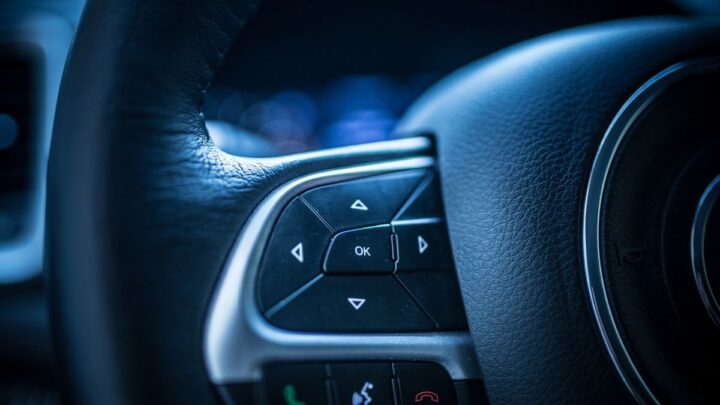
Most Common Reasons That Cruise Control Isn’t Working
1. bad cruise control switch.
One of the first things to check if your cruise control isn’t working is the switch. This is usually located on the steering wheel or stalk. If it’s a bad switch, then it might need to be replaced.
This is usually pretty easy to check because you can just try to turn the system on and see if it engages.
In most cars, a light will illuminate somewhere on your dash (or on the button itself) once you press the switch to turn on cruise control.
So if you hit the button or switch but you don’t see a light illuminate anywhere, it could be an indication that the button or switch itself is bad. But that’s not the only reason you might not see the light turn on.
2. Blown Fuse or Relay
Another pretty common reason that cruise control might not be working is because of a blown fuse or relay.
These are usually located in the fuse box under the hood. If you think this might be the case, then you can just check the fuse box to see if there’s a blown fuse or relay.
If you don’t see a blown fuse or relay, it could still be the problem. Sometimes the fuse or relay might not look blown but could still be bad.
In this case, you might need to use a multimeter to test the fuse or relay to see if it’s still good. Typically, a relay will audibly “click” when it’s activated, so if you don’t hear the clicking noise, the cruise control relay might be bad.
3. Engine or Transmission Problems (Check Engine Light)
If the cruise control system is engaged but the car doesn’t seem to be responding, it could be because of engine or transmission problems.
These types of problems can be pretty serious, so it’s definitely something you’ll want to get checked out by an experienced mechanic or technician. Often, this will be accompanied by your check engine light turning on.
Furthermore, sometimes the cruise control system won’t even engage if there are overarching issues with the engine or transmission that would prevent it from working.
This is more commonly seen in newer cars where the electronics and computer system are so advanced and integrated that it will prevent you from using cruise until you fix the underlying issues.
4. Faulty Vehicle Speed Sensor
One of the most common reasons that cruise control might not be working is because of a faulty vehicle speed sensor. This is the sensor that tells the cruise control system how fast you’re going.
If it’s not working correctly, then the cruise control system won’t be able to maintain the correct speed.
In most cases, a faulty speed sensor will need to be replaced. However, sometimes you can clean the sensor and fix the problem. This is usually pretty easy to do and you can find instructions online or in your car’s owner’s manual.
You usually have to jack your car up and remove the wheel to get to the sensor, so make sure you’re being careful and following the owner’s manual!
5. Bad Brake Pedal Switch
Another common reason for cruise control not working is a bad brake pedal switch. This switch is located on the brake pedal itself and tells the cruise control system when you’re pressing the brakes.
If it’s not working correctly, then the cruise control system won’t know when you’re trying to stop and it could cause some serious accidents .
In most cases, you’ll need to replace the switch if it’s not working correctly. However, if you’re lucky, you might be able to clean it and get it working again.
Sometimes it can even just come unplugged and all you need to do is plug it back in. Either way, this is a pretty easy fix that you should be able to do on your own.
6. Broken Cruise Control Cable
Last up on our list of the most common reasons cruise control might not be working is a broken cruise control cable. This is the cable that runs from the cruise control module to the throttle body.
If it’s broken, then the cruise control system won’t be able to tell how much gas to give the engine and it won’t work correctly.
The vast majority of the time, you need to replace the cruise control cable if it’s broken. However, sometimes it might have just come loose or come off the track at the throttle body and you just need to reattach it correctly.
This cable has to have the correct amount of tension in order to operate properly, so you might want to leave this one up to the professionals if you aren’t confident about it!
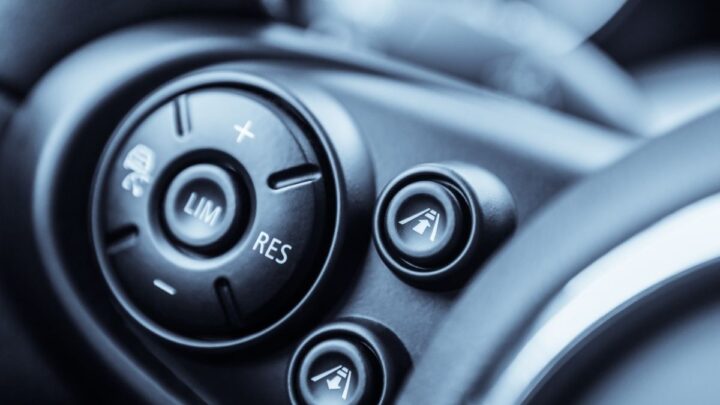
How Hard is it to Fix Cruise Control on Your Car?
Now that you know why your cruise control might not be working, you’re probably wondering if it’s something you can handle on your own. That really depends on what the problem is.
As you can see from the list above, some of the issues are pretty easy to fix, like a blown fuse or bad brake pedal switch, while others are pretty difficult, like engine or transmission problems.
If you’re having trouble with your cruise control, the best thing to do is take it to a qualified mechanic or technician and have them diagnose the problem.
They’ll be able to tell you exactly what’s wrong and how difficult (and expensive) it will be to fix. Most of the issues with cruise control are fairly simple and inexpensive, and the convenience of the feature usually makes the repair worth it!
Conclusion on Common Issues For Cruise Control
There are a few different reasons why cruise control might not be working in your car anymore, including a broken switch, a blown fuse or relay, or faulty speed sensors.
Whatever the problem may be, figuring it out is the first step so you can go back to cruising on the roads without a problem.
We hope this article helped shed some light on why cruise control might not be working in your car.
Be sure to take it to a professional if you’re having any trouble so they can help you get back on the road safely!
Hi, I'm the founder of VehicleAnswers.com! Having owned a wide variety of vehicles in my life, I was astounded at how hard it can be to find answers to common automotive questions. Rather than sit idly, I decided to create this website to help others!
Fixing Faulty Cruise Control
Alarmingly, the speedometer needle steadily winds down from 75 mph toward 50. Just as you uncurl your feet and try to accelerate back to traffic speeds, the vehicle downshifts with a lurch and abruptly climbs back to over 80 mph. So you tap the brakes and disengage the cruise control to avoid a conversation with one of the many law enforcement officers lurking behind every other billboard. Toggling the Resume switch settles things down, holding to a legal speed on both the uphill and downhill sections of the interstate. The kids in the back seat have stopped threatening to throw up, too. Then you look in your mirror 20 miles later and see the lights. Red and blue flashing lights. You're doing over 85 mph and, odds are, Smokey isn't going to believe you have the cruise set to 70. Time to find out why your cruise control has a mind of its own.
IT'S NOT A BUG, IT'S A FEATURE Does your cruise control fall out of engagement partway up steep hills? Actually, it will normally drop out if the engine has to work too hard, mainly because after a while there isn't enough vacuum left to pull in the servo after sustained near-wide-open-throttle. You'll just have to put your foot into it. Downshifting helps.
Does your Japanese car not remember the set speed after tollbooths? Unlike most American and European cars, some Toyotas and Hondas are designed not to remember their set speed if the vehicle speed falls below 25 mph, and you're supposed to accelerate the vehicle to your set speed and hit the Set button again. Annoying, but that's the way they were designed.
Do you have to ride the brakes on longer downhills to keep from building up excess speed? That's normal too. The cruise control only has authority to reduce engine speed to idle. It doesn't activate the brakes. Modern cars, in an attempt to improve mileage, have very tall gear ratios, low-friction engine designs, low-rolling-resistance tires and optimized aerodynamics. That long downgrade outside of town may have accelerated your '60s-era Pontiac to only a couple of miles per hour above legal. But, it may well propel your new economy car to blatantly illegal velocities unless you intervene by braking or downshifting.

WHAT'S THAT HISS?: Most common cause of erratic cruise control? Vacuum leaks caused by deteriorated hoses.
SMOOTH AND STEADY Cruise control on your vehicle is a terrific device. It substantially reduces the driver's workload on longer trips, and can save substantial amounts of fuel and expense over the life of the vehicle--until it stops working.
We'll get to the scenario of not holding a steady speed later, but here are a couple of things to check immediately if the cruise control is on strike.
Does the Cruise icon on the dash light up when you turn the switch on? Duh. Check the fuse. You may need to look in the owner's manual to see which one if it's not tagged on the fuse box cover. An aftermarket cruise may have an inline fuse holder in the wiring to the controller.
If there is power to the system, the next check is the brake lights. Brake lights? Yup, cruise controls have a switch to toggle them off when you touch the brake pedal, and many use the same switch as the brake lights. If one of the brake lights has failed, the cruise control thinks the brakes are on all the time and won't come on. Same result if the switch is incorrectly adjusted or broken or jammed. Wait, there's more--if your vehicle has a manual transmission, there's a similar switch on the clutch pedal. You may need to break out a test light or multimeter to verify the function of this array of switches. These switches usually are normally closed switches, and close their contacts when the pedal is depressed. We've seen several cases of intermittent cruise control dropout caused by a brake light switch that was adjusted very tight. Any small bump would jiggle the brake pedal down far enough to toggle the brake lights on for a brief instant--long enough to shut down the cruise. Adjusting the switch to specs (usually so the brake lights come on after the pedal travels 1/2 in.) fixed it.
Once you verify all of these things, it's time to look for more subtle causes. Check underhood. Inspect the linkage between the cruise control actuator and the throttle. It may be as simple as a toilet-tank bead chain or a separate throttle cable with its own actuator cam to the throttle body. Look for disconnected or damaged wiring to the controller or actuator, particu-larly if it's an aftermarket system, which may have been installed by someone with poor mechanical skills.
Another obvious failure point is the vacuum line to the actuator. If it has fallen off, there's no vacuum to the actuator and no force can be applied to the throttle. We'll get ahead of ourselves here and mention that a vacuum line that looks fine may have a subtle leak caused by aging, brittle rubber or connections that don't seal well. A lot of the cruise controls we've seen with issues in regulating their speed correctly are fixed by simply replacing all the vacuum lines between the servo, vacuum reservoir (if there is one) and the intake manifold vacuum supply.
WHOA, NELLIE!: If your brake light switch is incorrectly adjusted, your cruise control may not lock in. A burned-out brake light can do the same.
WHAT'S THIS THING?: The cruise control servo motor could be anywhere in the engine compartment.
CONTROL ISSUE WITH YOUR SERVO There are two main components of the cruise control system: the controller and the servo.
The controller integrates all the inputs and tells the servo how far to actuate the throttle plates. Normally, there is no way you can service this item, so if you trace a problem to the controller, you'll have to buy a new one. A bad controller probably will require a service manual for specific diagnostics. You'll also need a scan tool to access any computer trouble codes to boot.
The servo does the work of moving the throttle blades to speed up the vehicle. Conventional systems are actuated by manifold vacuum. Check the linkage from the servo to the throttle to ensure it's properly hooked up and not binding or sticky. Inside the servo is a diaphragm that moves to pull on the linkage. Some older systems, used on cars or trucks that don't have throttle-position sensors, may have a rod that moves in and out of a magnetic coil to tell the controller the throttle position. There are also two electrically operated solenoid valves. One valve admits vacuum to the diaphragm chamber to add more throttle. The other bleeds air back into the chamber to reduce throttle. Normally, they will never be open at the same time, so if one is sticky or leaking, cruise control operation will be erratic at best. Check for leakage with a handheld vacuum pump. A leaky valve may benefit from a quick shot of silicone spray.
Diesels and some late models may use a servo that is completely electrical. These usually are mounted on the fenderwell or firewall, and are connected to the throttle by a second throttle cable. Other than keeping the cable lubricated and properly adjusted, there's not much to fiddle with. As always, check the shop manual for specifics on your vehicle.
Many late-model cars have throttle plates connected directly to an actuator controlled by the engine management computer. There is no physical connection between your right foot and the throttle blades (Scary, eh?), and there may or may not be a separate cruise control servo or controller.
HOW FAST WAS I GOING, OFFICER? If you still have no engagement, there may be an issue with the cruise control's speed input. Modern cars use information from the ABS's vehicle speed sensor (VSS) because the engine-management computer needs to know road speed. If your Check Engine light is on, the cruise may not work, especially if the VSS is malfunctioning. Older vehicles may use speed information from the speedometer. Aftermarket systems may resort to a ring of magnets clamped to a driveshaft or axle shaft, with a magnetic coil positioned nearby. If the magnets have fallen off or the coil has been smashed by a rock or road debris, there's no speed data for the controller.
URBAN LEGEND The legend has been related to us by all manner of people, including a couple of state police officers. Using the cruise control in rainy or slick conditions will make your car speed up uncontrollably, until you lose control and crash. It's a myth. Engaging the cruise will not make the car speed up. The cruise will attempt to maintain a steady speed. If the wheels lose traction and the car starts to slow down, the cruise will speed up the engine to attempt to accelerate back to the set speed. This will make the drivewheels spin more briskly. The vehicle speed will go slower, regardless of how furiously the wheels spin. If you have a rear-wheel-drive car, the effect is to destabilize the vehicle, and you probably will spin out unless the vehicle regains traction in a reasonable length of time. A front-wheel-drive car with spinning tires will attempt to continue in a more or less straight line--which will make steering control dodgy at best.
Heavy rain or snow makes use of the cruise control inadvisable, but such conditions certainly won't make your car accelerate to ludicrous speeds while you hang on for dear life. If the cruise is engaged and you perceive a loss of traction, the best bet is to tap the brake to disengage the system, and then add just enough throttle to maintain steering until the vehicle slows down to a more appropriate speed.
WHERE'S THIS THING?: Speed sensor may be buried under the dash near speedo head.
SUCK IT UP: The vacuum reservoir provides an added source of vacuum for those long uphill grades.

The Best Labor Day Tire Sales of 2024
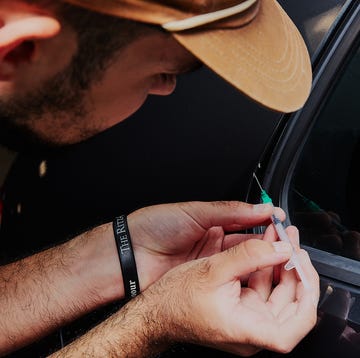
Automotive Touch Up Paint 101

The 8 Best Portable Jump Starters

The Best Carports for Weather Protection
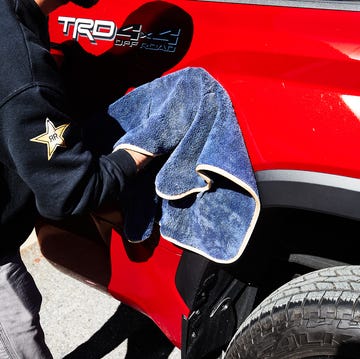
The Best Car Waxes to Protect Your Paint Job

Score the Best Portable Jump Starter for 41% Off

The Best Car Vacuums

Tesla's FSD Software May Be Too Good To Be True

The Best Car Battery Chargers to Buy Now

The 7 Best Jumper Cables for Your Car

The 6 Best Car Sun Shades

How Toyota is Reducing Your Carbon Footprint

CarParts.com will be back soon!
We apologize for the inconvenience. The CP Team is working on some upgrades to improve our service. Thank you for using CarParts.com!
You can call us at
1-866-529-0412
Reference ID: 18.6fc733e.1725070333.aee0357

- Forum Listing
- Marketplace
- Advanced Search
- RAV4.1 First Generation (1994-2000 Models)
- 4.1 Faults & Fixes
Faulty cruise control, clutch switch, and brake lights all fixed
- Add to quote
- ?
- 155.8K members
Top Contributors this Month

Cruise control not working, ABS light on, brake light on
Diagnose and fix cruise control not working on gm vehicles.
The infamous GM ignition switch failures can show up in many ways. One that baffles many people is when they the cruise control not working along with the ABS light on and the Red brake light on. The key to diagnosing the issue is when you find there’s no power at fuses 44, 48, 39, 51 and 52 in the rear fuse block.
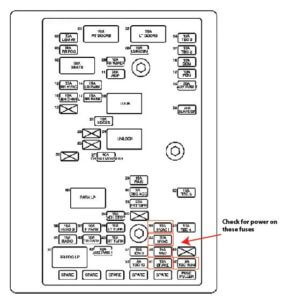
Chevrolet rear fuse box diagram
Check power at base of steering column
Disconnect connector C201 at the base of the steering column. With the key in the RUN position, check for battery voltage on terminals D1 and B5. If you detect LESS than full battery voltage at D1, check voltage at B5. Both should have full battery voltage. If not, replace the ignition switch
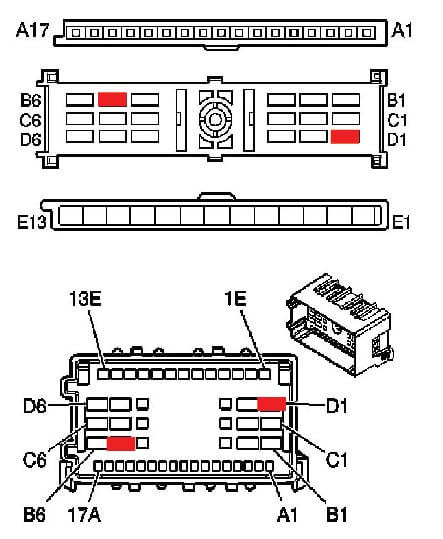
Connector C201 at base of steering column
Replace ignition switch
Disconnect battery
Disable airbag system and wait for it to power down
Remove the hush panel and knee bolster
Remove the steering column trim covers
Insert the key and turn to RUN position.
Push a hex key into the hole on top of the lock cylinder and push down. Pull the lock cylinder straight out.
Use tool J42759 or another tool to release the lock tabs holding the ignition switch in place.
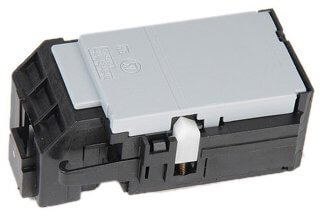
Chevrolet ignition switch
Pull the IGN switch out of the lock cylinder housing. Disconnect the electrical connector
DO NOT ALTER the position of the GEARS between the lock cylinder and the ignition switch. You MUST verify that the gear is in the proper position before installing the new switch. If you don’t, the misalignment will cause the switch to remain in partial ON position and drain your battery. Insert a screwdriver and turn the gear to align if you’ve moved it.
Insert the new IGN switch and make sure the tabs lock into the lock cylinder housing.
Once in place, use a screwdriver to operate the IGN switch to confirm it’s aligned and working properly BEFORE you reinstall the lock cylinder
©, 2018 Rick Muscoplat
- Trailblazer
- cruise control not working
- ASK A QUESTION
- REPAIR GUIDES
- BECOME A MEMBER
- LOG IN Login with Facebook OR Remember me NOT A MEMBER? FORGOT PASSWORD?
- PRIVACY POLICY
- TERMS AND CONDITIONS
Cruise Control
- Not Working
My cruise control doesn't work?
- 2003 BUICK LESABRE
- 121,000 MILES
- 20,758 POSTS

- 2002 BUICK LESABRE

- 8,548 POSTS
- 80,000 MILES
- 2001 BUICK LESABRE
- 44,000 MILES
- 75,000 MILES
- 1,209 POSTS
- 2000 BUICK LESABRE
- 128,000 MILES
Please login or register to post a reply.
Related cruise control not working content, dash lights and interior lights not working, buick rear view mirror, 2000 buick lesabre cruise control, 1994 buick le sabre interior lights blink, sponsored links.

- Contact •
- Help •
- About •
- Privacy Policy •
- Terms & Conditions

IMAGES
VIDEO
COMMENTS
The most common reason a cruise control stops working is due to a blown fuse or a defective brake pedal switch. It can also be caused by issues with the throttle control system or the ABS. In older cruise control systems, it can be caused by a broken vacuum line. Here is a more detailed list of the possible reasons your cruise control is not ...
Faulty brake lights In many vehicles, the brake lights are looped into the same circuit as the cruise control unit. So, when a brake light goes out, it takes the cruise control unit down with it. Diagnosing this problem: Have a friend sit in your driver's seat and press the brake pedal. Walk around your car and confirm the brake lights are working.
Symptom 1 — brake pedal does not disengage cruise control. There's a switch fixed to the bases of the brake pedal and if cruise control does not deactivate when braking then it's a sign that this switch is faulty. Symptom 2 — Hissing noises are heard from under the dash. The cruise control switch is a vacuum system and for some vehicles ...
Brake Lights - In some systems, cruise control is disabled when a brake light is blown. Aftermarket lighting, such as LED brake light conversion, might trick the CCM into thinking a brake light is blown, as LED bulbs draw less current than incandescent bulbs. Fuses and Relays - On some vehicles, fuses and relays are used to protect the ...
Faulty 'cork spring' or 'spiral cable' - as mentioned this connects the steering wheel controls to the car's computer. There are many reasons why your car's cruise control system is not working, including brake light switch faults; worn out control switch; and ABS sensor faults.
7) Loose or Broken Cruise Control Cable. Older vehicles that are equipped with cruise control have two throttle cables - one for the gas pedal and one for the cruise control system. These cables may stretch over time. If the cruise control cable has stretched or is broken, the cruise control system will not be able to operate the throttle ...
Some cruise control systems are disabled when the brake lamp is blown. Check your brake lights. If you find a burnt brake light, just replace it and test the system again. Reason #3. Defective brake light switch. A defective pedal switch can also make your cruise control stop working.
2. Blown Fuse or Relay. Another pretty common reason that cruise control might not be working is because of a blown fuse or relay. These are usually located in the fuse box under the hood. If you think this might be the case, then you can just check the fuse box to see if there's a blown fuse or relay.
Yup, cruise controls have a switch to toggle them off when you touch the brake pedal, and many use the same switch as the brake lights. If one of the brake lights has failed, the cruise control ...
A problem with the brake switch (or clutch switch), cruise control switch, or VSS can cause issues in any system. More advanced cruise control systems have additional sensing devices (e.g., APP sensors), that can also cause problems. Some vehicles rely solely on a dedicated module to govern the cruise control system.
Replacing a brake lamp switch on an Escalade to repair Cruise Control. Cruise control button on steering wheel lights up, but cruise control on dashboard do...
If your brake lights stay on or your Cruise control will not set this may be your problem. A little stop on the brake pedal frame is the cause. An easy fix. ...
If your brake lights wont turn off or your cruise control won't turn on, there is a pretty good chance that its just two tiny plastic stoppers that have brok...
The brakelight switch in these trucks is a 4 pin, single plunger 2 stage switch. The first stage is 1mm and it kills the cruse control. or if open/closed whichever is the NOT the normally left in position it won't affect the brake lights but WILL keep cruise from coming on.
As most of you know, the most common issues with non-working cruise control usually have to do with failed brake/clutch switches or broken wires from the stem switch. Thus began my excursion under the dash a few years ago. On occasion I would get a wild hair and decide to try to chase this down. I replaced the brake switch.
The cruise control on my 2009 Silverado would not work at times. There were a few posts saying the brake lights would stick on causing the cruise not to work, but my brake lights worked fine. I bought a new brake light switch and found out that there are two separate inputs and outputs on the switch - one for the lights and one going to the ...
Clutch Cruise Control Switch After replacing these 3 switches with a 14mm wrench and soldering on a new plug that I took from a nearby junkyard for the clutch safety switch I now have properly working brake lights, the car only starts with the clutch on, and my cruise control works perfectly.
Cruise control not working, ABS light on, brake light on Diagnose and fix cruise control not working on GM vehicles. The infamous GM ignition switch failures can show up in many ways. One that baffles many people is when they the cruise control not working along with the ABS light on and the Red brake light on.
I just bought a 2010 GMC Sierra 4.8L V8 and went to use the cruise control one day and it didn't work. I saw something about replacing the brake light switch so I replaced that and the cruise control still doesn't work. The light on the dash doesn't even come on. Any help is appreciated, thanks!!
How to fix typical brake light and cruise control problems on Honda and Acura. Problem is caused by a plastic button either deforming or breaking off the br...
Originally Posted by tcp2. The CC is a result of the lights being on all the time. Pressing the brake disengages the CC so it will never set when it thinks you are on the brakes. Hunt down the light issue. That makes sense, truck thinks the parking brake is engaged so it won't allow cruise control. Reply Like.
Cruise control will not remain selected when button is pushed on steering left wheel spoke. Light will remain on as long as you hold the selector down. When you release the button the amber light will extinguish. During the time you hold the button down the system can be engaged but when ON/OFF select button is released the light extinguishes ...
Side note: I bought a GM vehicle once that had DTR lights which basically had the headlights on all the time, one way to get them to stay off was to engage the E-brake by one click and then start the vehicle, well instead of doing that the previous owner took the wire going to the E-stop and permanently grounded it which did prevent the ...